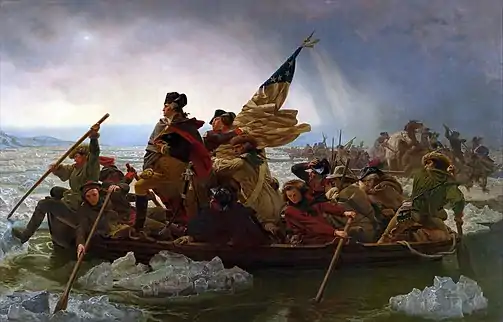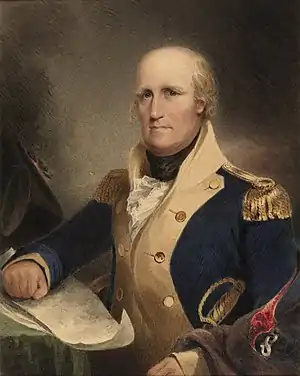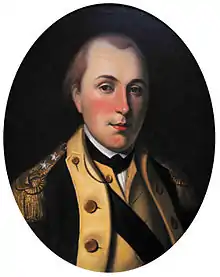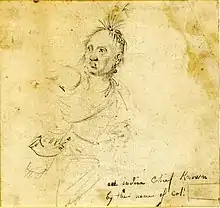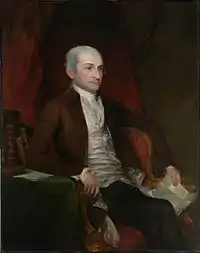American Revolutionary War
The American Revolutionary War (1775–1783), also known as the American War of Independence or the Revolutionary War, was initiated by delegates from the thirteen American colonies in Congress against Great Britain over their objection to Parliament's taxation policies and lack of colonial representation.[lower-alpha 13] From their founding in the 1600s, the colonies were largely left to govern themselves. The cost of victory in the 1754 to 1763 French and Indian War and 1756 to 1763 Seven Years' War left the British government deeply in debt; attempts to have the colonies pay for their own defense were vigorously resisted. The Stamp Act and Townshend Acts provoked colonial opposition and unrest, leading to the 1770 Boston Massacre and 1773 Boston Tea Party. When Parliament imposed the Intolerable Acts upon Massachusetts, twelve colonies sent delegates to the First Continental Congress to draft a Petition to the King and organize a boycott of British goods.[lower-alpha 14]
| American Revolutionary War | |||||||||
|---|---|---|---|---|---|---|---|---|---|
.jpg.webp) Left, Continental infantry at Redoubt 10, Yorktown; Washington rallying the broken center at Monmouth; USS Bonhomme Richard capturing HMS Serapis | |||||||||
| |||||||||
| Belligerents | |||||||||
|
Co-belligerents Combatants |
Treaty auxiliaries | ||||||||
| Commanders and leaders | |||||||||
|
|
| ||||||||
| Strength | |||||||||
| |||||||||
| Casualties and losses | |||||||||
Fighting broke out on 19 April 1775: the British garrison at Boston was harassed by Massachusetts militia at Lexington and Concord after destroying colonial Assembly powder stores. In June the Second Continental Congress appointed George Washington to create a Continental Army and oversee the capture of Boston. The Patriots sent their Olive Branch Petition to the King and Parliament, both of whom rebuffed it. In response they invaded British Quebec but were repulsed. In July 1776, Congress unanimously passed the Declaration of Independence. Hopes of a quick settlement were supported by American sympathizers within Parliament who opposed Lord North's "coercion policy" in the colonies. However, after the British were driven out of Boston the new British commander-in-chief, General Sir William Howe, launched a counter-offensive and captured New York City. After crossing the Delaware Washington engaged and routed Hessian forces at the Battle of Trenton and the British at the Battle of Princeton. After British General Burgoyne surrendered at the Battles of Saratoga in October 1777, Howe's 1777–1778 Philadelphia campaign captured that city. Washington retreated to Valley Forge during the winter of 1777–1778 where Prussian allied General von Steuben drilled the largely untrained Continental Army into an organized fighting unit.
French Foreign Minister Vergennes saw the war as a way to create an America economically and militarily dependent on France, not Britain. Although talks on a formal alliance began in late 1776, they proceeded slowly until Patriot victory at Saratoga in October 1777. Fears Congress might come to an early settlement with Britain resulted in France and the United States signing two treaties in February 1778. The first was a commercial treaty, the second a Treaty of Alliance; in return for a French guarantee of American independence, Congress agreed to join the war against Britain and defend the French West Indies. Although Spain refused to join the Franco-American alliance, in the 1779 Treaty of Aranjuez they agreed to support France in its global war with Britain, hoping to regain losses incurred in 1713.
In other fronts in North America, Governor of Spanish Louisiana Bernardo Gálvez routed British forces from Louisiana. The Spanish, along with American privateers supplied the 1779 American conquest of Western Quebec (later the US Northwest Territory).[31] Gálvez then expelled British forces from Mobile during the Battle of Fort Charlotte and the Siege of Pensacola, cutting off British military aid to their American Indian allies in the interior southeast. Howe's replacement, General Sir Henry Clinton, then mounted a 1778 "Southern strategy" from Charleston. After capturing Savannah, defeats at the Battle of Kings Mountain and the Battle of Cowpens forced Cornwallis to retreat to Yorktown, where his army was besieged by an allied French and American force. An attempt to resupply the garrison was repulsed by the French navy at the Battle of the Chesapeake, and Cornwallis surrendered in October 1781.
Although their war with France and Spain continued for another two years, Yorktown ended the British will to continue the war in North America. The North Ministry was replaced by Lord Rockingham, who accepted office on the basis George III agreed to American independence. Preliminary articles were signed in November 1782, and in April 1783 Congress accepted British terms; these included independence, evacuation of British troops, cession of territory up to the Mississippi River and navigation to the sea, as well as fishing rights in Newfoundland. On September 3, 1783, the Treaty of Paris was signed between Great Britain and the United States, then ratified the following spring.
Prelude to revolution
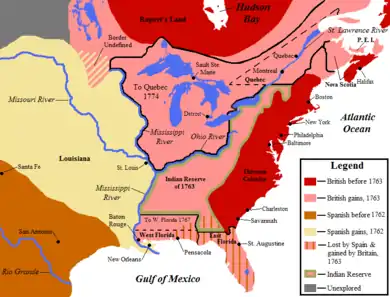
The French and Indian War and the wider conflict known as the Seven Years' War ended with the 1763 Peace of Paris, which expelled France from North America.[32] At the same time, the British rescinded provisions of colonial charters claiming to extend from the Atlantic to the Pacific; the Mississippi River became the dividing line between British and Spanish possessions in the Americas, with free navigation on it "to the open sea". More American territory changed hands in 1763 than any settlement before or after, destabilising existing alliances and trade networks, and leading to conflict between settlers and American Indians.[33]
The Proclamation Line of 1763 was intended to refocus colonial expansion north into Nova Scotia or south into Florida, while separating American Indians and colonials by restricting settlement in the west. Both sides agreed with the principle but disagreed on where to set the border; keeping the peace required garrisons of regular troops along the frontier, and led to disputes with the colonial legislatures over who should bear the expense.[34]
Taxation and legislation
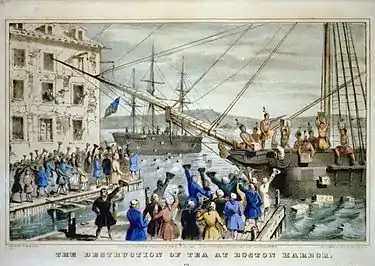
Although directly administered by the Crown, acting through a local Governor, the colonies were largely governed by native-born property owners. While external affairs were managed by London, colonial militia were funded locally but with the ending of the French threat in 1763, the legislatures expected less taxation, not more. At the same time, the huge costs of the Seven Years' War meant Parliament expected the colonies to fund their own defense.[34] The outcome was a series of disputes as to how these expenses should be paid.[35]
The 1763 to 1765 Grenville ministry began by instructing the Royal Navy to clamp down on smuggled goods and enforce customs duties levied in American ports.[34] The most important was the 1733 Molasses Act; routinely ignored prior to 1763, it had a significant economic impact since 85% of New England rum exports were manufactured from imported molasses. These measures were followed by the Sugar Act and Stamp Act, which imposed additional taxes on the colonies to pay for defending the western frontier.[36] In July 1765, the Whigs formed the First Rockingham ministry, which repealed the Stamp Act and reduced tax on foreign molasses to help the New England economy, but re-asserted Parliamentary authority in the Declaratory Act.[37]
%252C_The_Bostonians_Paying_the_Excise-man%252C_or_Tarring_and_Feathering_(1774)_-_02.jpg.webp)
However, this did little to end the discontent; in 1768, a riot started in Boston when the authorities seized the sloop Liberty on suspicion of smuggling.[38] Tensions escalated further in March 1770 when British troops fired on rock-throwing civilians, killing five in what became known as the Boston Massacre.[39] The Massacre coincided with the partial repeal of the Townshend Acts by the Tory-based North Ministry, which came to power in January 1770 and remained in office until 1781. North insisted on retaining duty on tea to enshrine Parliament's right to tax the colonies; the amount was minor, but ignored the fact it was that very principle Americans objected to.[40]
Tensions escalated following the destruction of a customs vessel in the June 1772 Gaspee Affair, then came to a head in 1773. A banking crisis led to the near collapse of the East India Company, which dominated the British economy; to support it, Parliament passed the Tea Act, giving it a trading monopoly for North America. Since most American tea was smuggled by the Dutch, the Act was opposed by those who managed the illegal trade, while being seen as yet another attempt to impose the principle of taxation by Parliament.[41] After the December 1773 Sons of Liberty protest known as the Boston Tea Party, Parliament passed the so-called Intolerable Acts. While aimed specifically at Massachusetts, many in America and within the Whig opposition considered them a threat to liberty in general; it led to increased sympathy for the Patriot cause locally, as well as in Parliament and the London press.[42]
Break with the British Crown
Over the course of the 18th century, the elected lower houses in the colonial legislatures gradually wrested power from their Royal Governors.[43] Dominated by smaller landowners and merchants, these Assemblies now established ad hoc provincial legislatures, variously called Congresses, Conventions, and Conferences, effectively replacing Royal control. With the exception of Georgia, twelve colonies sent representatives to the First Continental Congress to agree a unified response to the crisis.[44] Many of the delegates feared that an all out boycott would result in war and sent a Petition to the King calling for repeal of the Intolerable Acts.[45] However, after some debate, on September 17, 1774, Congress endorsed the Massachusetts Suffolk Resolves and on October 20 passed the Continental Association; based on a draft prepared by the First Virginia Convention in August, this instituted economic sanctions against Britain.[46]
- Colonial response
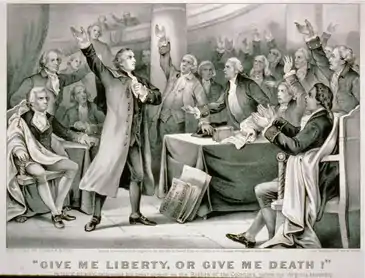 Patrick Henry, "Give me liberty or give me death!", 2nd Virginia Convention, reported throughout the colonies
Patrick Henry, "Give me liberty or give me death!", 2nd Virginia Convention, reported throughout the colonies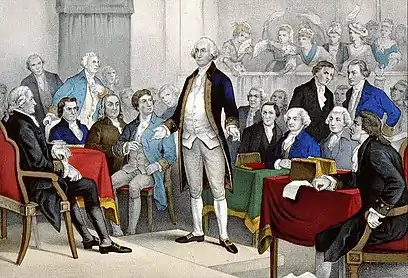 July 1775; George Washington (standing, center) appointed Commander-in-Chief by Congress
July 1775; George Washington (standing, center) appointed Commander-in-Chief by Congress
While denying its authority over internal American affairs, a faction led by James Duane and future Loyalist Joseph Galloway insisted Congress recognise Parliament's right to regulate colonial trade.[46] [lower-alpha 15] Expecting concessions by the North administration, Congress authorized the extralegal committees and conventions of the colonial legislatures to enforce the boycott; this succeeded in reducing British imports by 97% from 1774 to 1775.[47] However, on February 9 Parliament declared Massachusetts to be in a state of rebellion and instituted a blockade of the colony.[48] In July, the Restraining Acts limited colonial trade with the British West Indies and Britain and barred New England ships from the Newfoundland cod fisheries. The increase in tension led to a scramble for control of militia stores, which each Assembly was legally obliged to maintain for defense.[49] On April 19, a British attempt to secure the Concord arsenal culminated in the Battles of Lexington and Concord which began the war.[50]
- North America, showing European colonial boundaries and American Indians language groups
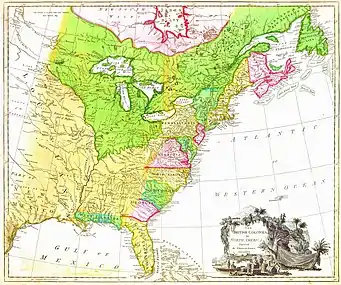 British North America 1777; note post-1763 concessions from France (green) and Spain (yellow)
British North America 1777; note post-1763 concessions from France (green) and Spain (yellow) North America; major American Indians language groups and tribal boundaries
North America; major American Indians language groups and tribal boundaries
Political reactions
After the Patriot victory at Concord, moderates in Congress led by John Dickinson drafted the Olive Branch Petition, offering to accept royal authority in return for George III mediating in the dispute.[51] However, since it was immediately followed by the Declaration of the Causes and Necessity of Taking Up Arms, Colonial Secretary Dartmouth viewed the offer as insincere; he refused to present the petition to the king, which was therefore rejected in early September.[52] Although constitutionally correct, since George could not oppose his own government, it disappointed those Americans who hoped he would mediate in the dispute, while the hostility of his language annoyed even Loyalist members of Congress.[51] Combined with the Proclamation of Rebellion, issued on August 23 in response to the Battle at Bunker Hill, it ended hopes of a peaceful settlement.[53]
Backed by the Whigs, Parliament initially rejected the imposition of coercive measures by 170 votes, fearing an aggressive policy would simply drive the Americans towards independence.[54] However, by the end of 1774 the collapse of British authority meant both North and George III were convinced war was inevitable.[55] After Boston, Gage halted operations and awaited reinforcements; the Irish Parliament approved the recruitment of new regiments, while allowing Catholics to enlist for the first time.[56] Britain also signed a series of treaties with German states to supply additional troops.[57] Within a year it had an army of over 32,000 men in America, the largest ever sent outside Europe at the time.[58]
%252C_by_John_Trumbull.jpg.webp)
Adams, Sherman, Livingston,
Jefferson, Franklin (l-r presenting)
However, the use of German mercenaries and Catholics was opposed by many in Parliament and the Protestant-dominated colonial assemblies; combined with the lack of activity by Gage, it allowed the Patriots to take control of the legislatures.[59] Support for independence was boosted by Thomas Paine's pamphlet Common Sense, which was widely reprinted.[60] To draft a Declaration of Independence, Congress appointed the Committee of Five, consisting of Thomas Jefferson, John Adams, Benjamin Franklin, Roger Sherman and Robert Livingston.[61] Identifying the inhabitants of the thirteen colonies as "one people", it simultaneously dissolved political links with Britain, while including a long list of alleged violations of "English rights" committed by George III.[62]
On July 2, Congress voted for independence and published the declaration on July 4,[63] which Washington read to his troops in New York City on July 9.[64] At this point, the Revolution ceased to be an internal dispute over trade and tax policies and became a civil war. The states as represented in Congress were engaged in struggle with Britain, but each in turn was split between Patriots and Loyalists.[65] Patriots generally supported independence from Britain and a new national union in Congress, while Loyalists remained faithful to British rule. Estimates of numbers vary, one suggestion being the population as a whole was split evenly between committed Patriots, committed Loyalists and those who were indifferent.[66] Others calculate the spilt as 40% Patriot, 40% neutral, 20% Loyalist, but with considerable regional variations.[67]
At the onset of the war, the Congress realized defeating Britain required foreign alliances and intelligence-gathering. The Committee of Secret Correspondence was formed for "the sole purpose of corresponding with our friends in Great Britain and other parts of the world". From 1775 to 1776, it shared information and built alliances through secret correspondence, as well as employing secret agents in Europe to gather intelligence, conduct undercover operations, analyze foreign publications and initiate Patriot propaganda campaigns.[68] Paine served as secretary, while Silas Deane was instrumental in securing French aid in Paris.[69]
War breaks out
As the American Revolutionary War unfolded in North America, there were two principal campaign theaters within the thirteen states, and a smaller but strategically important one west of the Appalachian Mountains to the Mississippi River and north to the Great Lakes. The full-on military campaigning began in the states north of Maryland, and fighting was most frequent and severest there between 1775 and 1778. Patriots achieved several strategic victories in the South, the British lost their first army at Saratoga, and the French entered the war as an American ally.[70]
In the expanded Northern theater and wintering at Valley Forge, General Washington observed British operations coming out of New York at the 1778 Battle of Monmouth. He then closed off British initiatives by a series of raids that contained the British army in New York City. The same year, Spanish-supplied Virginia Colonel George Rogers Clark joined by Francophone settlers and their Indian allies conquered Western Quebec, the US Northwest Territory.
Starting in 1779, the British initiated a southern strategy to begin at Savannah, gather Loyalist support, and reoccupy Patriot-controlled territory north to Chesapeake Bay. Initially the British were successful, and the Americans lost an entire army at the Siege of Charleston, which caused a severe setback for Patriots in the region. But then British maneuvering north led to a combined American and French force cornering a second British army at Battle of Yorktown, and their surrender effectively ended the Revolutionary War.[66]
Early engagements
On April 14, 1775, Sir Thomas Gage, who was Commander-in-Chief, North America from 1763 to 1775 and appointed Governor of Massachusetts in 1774, received orders from London to take action against the Patriots. His plan was to secure militia ordnance stored at Concord and Lexington; based on speed and secrecy, it was intended to begin shortly after midnight on April 19 and surprise the militia before they could respond. However, Patriot intelligence learned of Gage's intentions, and Paul Revere alerted Captain John Parker, commander of the Concord militia.[71] The first action of the war was a brief skirmish at Lexington, followed by a full scale battle during the Battles of Lexington and Concord. After suffering some 300 casualties, British troops withdrew to Boston, followed by local militia who laid siege to the city.[72]
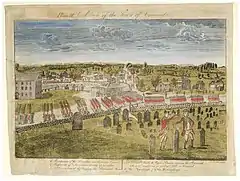
The next month 4,500 British reinforcements arrived with generals William Howe, John Burgoyne, and Sir Henry Clinton.[73] On June 17, they seized the Charlestown Peninsula at the Battle of Bunker Hill, a frontal assault in which they suffered over 1,000 casualties.[74] Dismayed at the costly attack which had gained them little,[75] Gage appealed to London to send a large army to suppress the revolt,[76] but instead they replaced him and Howe took command.[74]
On June 14, 1775, the Continental Congress officially assumed command of patriot forces in Boston, giving birth to the Continental Army, which now needed a Commander-in-Chief. At this time the delegates were so impressed with Washington that his appointment was considered a done deal.[77] To lead Patriot forces surrounding Boston, Congressional leader John Adams of Massachusetts nominated Virginia delegate George Washington for commander-in-chief of the Continental Army in June 1775. On June 16, John Hancock officially announced that Washington was henceforth "General and Commander in Chief of the army of the United Colonies."[78] Washington had previously commanded Virginia militia regiments in British combat commands during the French and Indian War.[79] He proceeded to Boston to assume field command of the ongoing siege on July 3.[80] Howe did not engage in a standoff with Washington,[81] and Washington made no plan to assault the city;[82] instead, the Americans fortified Dorchester Heights.
In early March 1776, Colonel Henry Knox arrived with heavy artillery captured from a raid on Fort Ticonderoga.[83] Under the cover of darkness Washington placed his artillery atop Dorchester Heights March 5,[84] threatening Boston and the British ships in the harbor. Howe feared another battle like Bunker Hill, so he evacuated Boston. The British were permitted to withdraw without further casualties on March 17 (known as Evacuation Day), and they sailed to Halifax, Nova Scotia. Washington then moved his army south to New York.[85]
Beginning in August 1775, American privateers began raiding villages in Nova Scotia, first at Saint John, then Charlottetown and Yarmouth. In 1776, John Paul Jones and Jonathan Eddy raided Canso and assaulted Fort Cumberland respectively.
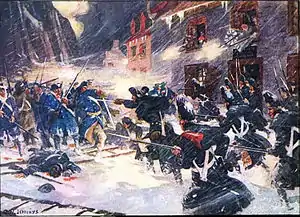
British officials in Quebec began negotiating with the Iroquois for their support,[86] while the Americans urged them to maintain neutrality.[87] Aware of Native American leanings toward the British and fearing an Anglo-Indian attack from Canada, Congress authorized an invasion of Quebec in April 1775.[88][lower-alpha 16]
The second American expedition into the former French territory was defeated at the Battle of Quebec on December 31,[89] and after a loose siege the Americans withdrew on May 6, 1776.[90] A failed American counter-attack at Trois-Rivières on June 8 ended their operations in Quebec.[91] However, British pursuit was blocked by American ships on Lake Champlain until they were cleared on October 11 at the Battle of Valcour Island. The American troops were forced to withdraw to Fort Ticonderoga, ending the campaign. In November 1776, a Massachusetts-sponsored uprising in Nova Scotia during the Battle of Fort Cumberland was dispersed.[92] The cumulative failures cost the Patriots support in local public opinion,[93] and aggressive anti-Loyalist policies in the New England colonies alienated the Canadians.[94] The Patriots made no further attempts to invade north.[95]
In Virginia, Royal Governor Lord Dunmore attempted to disarm the Assembly's militia as tensions increased, although no fighting broke out.[96] He issued a proclamation on November 7, 1775, promising freedom for slaves who fled their Patriot masters to fight for the Crown.[97] Dunmore's troops were repulsed at the Battle of Great Bridge, and Dunmore fled to British ships anchored off the nearby port at Norfolk. The Third Virginia Convention refused to disband its militia or accept martial law. In the last Royal Virginia Assembly session, speaker Peyton Randolph did not respond to Lord Dunmore concerning Parliament's Conciliatory Resolution. Negotiations failed in part because Randolph was also president of the first Virginia Conventions of Burgesses, and he deferred to the First Continental Congress, where he was also President. Dunmore ordered the ship's crews to burn Norfolk on January 1, 1776.[98]
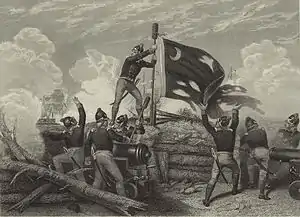
Battle of Sullivan's Island, June 1776
The Siege of Savage's Old Fields began on November 19 in South Carolina between Loyalist and Patriot militias,[99] and the Loyalists were subsequently driven out of the colony in the Snow Campaign.[100] Loyalists were recruited in North Carolina to reassert colonial rule in the South, but they were decisively defeated in the Battle of Moore's Creek Bridge and Loyalist sentiment was subdued.[101] A troop of British regulars set out to reconquer South Carolina, and launched an attack on Charleston during the Battle of Sullivan's Island on June 28, 1776,[102] but it failed and left the South in Patriot control until 1780.[103]
Shortages in Patriot gunpowder led Congress to authorize an expedition against the Bahamas in the British West Indies to secure additional ordnance there.[104] On March 3, 1776, the Americans landed and engaged the British at the Raid of Nassau, but the local militia offered no resistance.[105] The expedition confiscated what supplies they could and sailed for home on March 17.[106] A month later after a brief skirmish at the Battle of Block Island with the Royal Navy frigate HMS Glasgow, the squadron returned to the base of American naval operations during the Revolution at New London, Connecticut.[107]
British New York counter-offensive
After regrouping at Halifax, Nova Scotia, William Howe was determined to take the fight to the Americans.[108] He sailed for New York in June 1776 and began landing troops on Staten Island near the entrance to New York Harbor on July 2. The Americans rejected Howe's informal attempt to negotiate peace on July 30;[109] Washington knew that an attack on the city was imminent and realized that he needed advance information to deal with disciplined British regular troops. On August 12, 1776, Patriot Thomas Knowlton was given orders to form an elite group for reconnaissance and secret missions. Knowlton's Rangers, which included Nathan Hale, became the Army's first intelligence unit.[110][lower-alpha 17] When Washington was driven off Long Island he soon realized that he would need more than military might and amateur spies to defeat the British. He was committed to professionalize military intelligence, and with the aid of Benjamin Tallmadge, they launched the six-man Culper spy ring.[113][lower-alpha 18] The efforts of Washington and the Culper Spy Ring substantially increased effective allocation and deployment of Continental regiments in the field.[113] Over the course of the war Washington spent more than 10 percent of his total military funds on intelligence operations.[114]

Washington split his army to positions on Manhattan Island and across the East River in western Long Island.[115] On August 27 at the Battle of Long Island, Howe outflanked Washington and forced him back to Brooklyn Heights, but he did not attempt to encircle Washington's forces.[116] Through the night of August 28, General Henry Knox bombarded the British. Knowing they were up against overwhelming odds, Washington ordered the assembly of a war council on August 29; all agreed to retreat to Manhattan. Washington quickly had his troops assembled and ferried them across the East River to Manhattan on flat-bottomed freight boats without any losses in men or ordnance, leaving General Thomas Mifflin's regiments as a rearguard.[117]
General Howe officially met with a delegation from Congress at the September Staten Island Peace Conference, but it failed to conclude peace as the British delegates only had the authority to offer pardons and could not recognize independence.[118] On September 15, Howe seized control of New York City when the British landed at Kip's Bay and unsuccessfully engaged the Americans at the Battle of Harlem Heights the following day.[119] On October 18 Howe failed to encircle the Americans at the Battle of Pell's Point, and the Americans withdrew. Howe declined to close with Washington's army on October 28 at the Battle of White Plains, and instead attacked a hill that was of no strategic value.[120]

Washington's retreat isolated his remaining forces and the British captured Fort Washington on November 16. The British victory there amounted to Washington's most disastrous defeat with the loss of 3,000 prisoners.[121] The remaining American regiments on Long Island fell back four days later.[122] General Sir Henry Clinton wanted to pursue Washington's disorganized army, but he was first required to commit 6,000 troops to capture Newport, Rhode Island to secure the Loyalist port.[123][lower-alpha 19] General Charles Cornwallis pursued Washington, but Howe ordered him to halt, leaving Washington unmolested.[125]
The outlook was bleak for the American cause: the reduced army had dwindled to fewer than 5,000 men and would be reduced further when enlistments expired at the end of the year.[126] Popular support wavered, morale declined, and Congress abandoned Philadelphia for Baltimore.[127] Loyalist activity surged in the wake of the American defeat, especially in New York state.[128]
In London, news of the victorious Long Island campaign was well received with festivities held in the capital. Public support reached a peak,[129] and King George III awarded the Order of the Bath to Howe.[130] Strategic deficiencies among Patriot forces were evident: Washington divided a numerically weaker army in the face of a stronger one, his inexperienced staff misread the military situation, and American troops fled in the face of enemy fire. The successes led to predictions that the British could win within a year.[131] In the meantime, the British established winter quarters in the New York City area and anticipated renewed campaigning the following spring.[132]
Two weeks after Congress withdrew to safer Maryland, Washington crossed the ice-choked Delaware River about 30 miles upriver from Philadelphia on the night of December 25–26, 1776. His approach over frozen trails surprised Hessian Colonel Johann Rall. The Continentals overwhelmed the Hessian garrison at Trenton, New Jersey, and took 900 prisoners.[133][lower-alpha 20] The celebrated victory rescued the American army's flagging morale, gave new hope to the Patriot cause,[135] and dispelled much of the fear of professional Hessian "mercenaries".[136] Cornwallis marched to retake Trenton but was repulsed at the Battle of the Assunpink Creek;[137] in the night of January 2, Washington outmaneuvered Cornwallis and defeated his rearguard in the Battle of Princeton the following day. The two victories helped to convince the French that the Americans were worthwhile military allies.[138]
Washington entered winter quarters from January to May 1778 at Morristown, New Jersey,[139] and he received the Congressional direction to inoculate all Continental troops against smallpox.[140][lower-alpha 21] Although a Forage War between the armies continued until March,[142] Howe did not attempt to attack the Americans over the winter of 1776–1777.[143]
British northern strategy fails

The 1776 campaign demonstrated regaining New England would be a prolonged affair, which led to a change in British strategy. This involved isolating the north from the rest of the country by taking control of the Hudson River, allowing them to focus on the south where Loyalist support was believed to be substantial.[144] In December 1776, Howe wrote to the Colonial Secretary Lord Germain, proposing a limited offensive against Philadelphia, while a second force moved down the Hudson from Canada.[145] Germain received this on February 23, 1777, followed a few days later by a memorandum from Burgoyne, then in London on leave.[146]
Burgoyne supplied several alternatives, all of which gave him responsibility for the offensive, with Howe remaining on the defensive. The option selected required him to lead the main force south from Montreal down the Hudson Valley, while a detachment under Barry St. Leger moved east from Lake Ontario. The two would meet at Albany, leaving Howe to decide whether to join them.[146] Reasonable in principle, this did not account for the logistical difficulties involved and Burgoyne erroneously assumed Howe would remain on the defensive; Germain's failure to make this clear meant he opted to attack Philadelphia instead.[147]
Burgoyne set out on June 14, 1777 with a mixed force of British regulars, German auxiliaries and Canadian militia, and captured Fort Ticonderoga on July 5. As General Horatio Gates retreated, his troops blocked roads, destroyed bridges, dammed streams, and stripped the area of food.[148] This slowed Burgoyne's progress and forced him to send out large foraging expeditions; on one of these, more than 700 British troops were captured at the Battle of Bennington on August 16.[149] St Leger moved east and besieged Fort Stanwix; despite defeating an American relief force at the Battle of Oriskany on August 6, he was abandoned by his Indian allies and withdrew to Quebec on August 22.[150] Now isolated and outnumbered by Gates, Burgoyne continued onto Albany rather than retreating to Fort Ticonderoga, reaching Saratoga on September 13. He constructed defenses around the town and asked Clinton for support while constructing defenses around the town.[151]
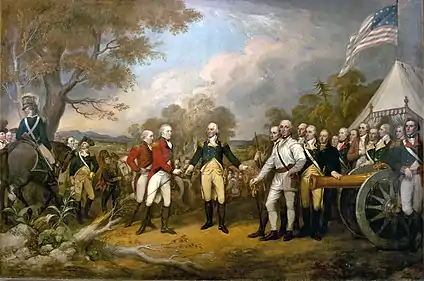
Morale among his troops rapidly declined, and an unsuccessful attempt to break past Gates at the Battle of Freeman Farms on September 19 resulted in 600 British casualties.[152] When Clinton advised he could not reach them, Burgoyne's subordinates advised retreat; a reconnaissance in force on October 7 was repulsed by Gates at the Battle of Bemis Heights, forcing them back into Saratoga with heavy losses. By October 11, all hope of escape had vanished; persistent rain reduced the camp to a "squalid hell" of mud and starving cattle, supplies were dangerously low and many of the wounded in agony.[153] Burgoyne capitulated on October 17; around 6,222 soldiers, including German forces commanded by General Riedesel, surrendered their arms before being taken to Boston, where they were to be transported to England.[154]
After securing additional supplies, Howe made another attempt on Philadelphia by landing his troops in Chesapeake Bay on August 24.[155] He now compounded failure to support Burgoyne by missing repeated opportunities to destroy his opponent, defeating Washington at the Battle of Brandywine on September 11, then allowing him to withdraw in good order.[156] After dispersing an American detachment at Paoli on September 20, Cornwallis occupied Philadelphia on September 26, with the main force of 9,000 under Howe based just to the north at Germantown.[157] Here they were attacked by Washington on October 4, but repulsed.[158]
To prevent Howe's forces in Philadelphia being resupplied by sea, the Patriots erected Fort Mifflin and nearby Fort Mercer on the east and west banks of the Delaware respectively, and placed obstacles in the river south of the city. This was supported by a small flotilla of Continental Navy ships on the Delaware, supplemented by the Pennsylvania State Navy, commanded by John Hazelwood. An attempt by the Royal Navy to take the forts in the October 20 to 22 Battle of Red Bank failed;[159][160] a second attack captured Fort Mifflin on November 16, while Fort Mercer was abandoned two days later when Cornwallis breached the walls.[161] His supply lines secured, Howe tried to tempt Washington into giving battle, but after inconclusive skirmishing at the Battle of White Marsh from December 5 to 8, he withdrew to Philadelphia for the winter.[162]
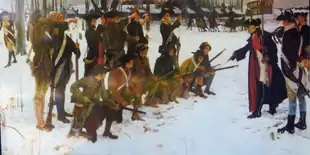
"Model Infantry" at Valley Forge
On December 19, the Americans followed suit and entered winter quarters at Valley Forge; while Washington's domestic opponents contrasted his lack of battlefield success with Gates' victory at Saratoga,[163] foreign observers such as Frederick the Great were equally impressed with Germantown, which demonstrated resilience and determination.[164] Over the winter, poor conditions, supply problems and low morale resulted in 2,000 deaths, with another 3,000 unfit for duty due to lack of shoes.[165] However, Baron Friedrich Wilhelm von Steuben took the opportunity to introduce Prussian Army drill and infantry tactics to the entire Continental Army; he did this by training "model companies" in each regiment, who then instructed their home units.[166] Despite Valley Forge being only twenty miles away, Howe made no effort to attack their camp, an action some critics argue could have ended the war.[167]
Foreign intervention
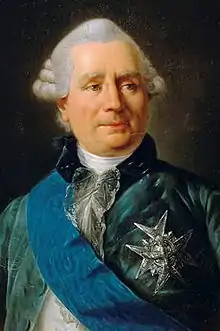
Like his predecessors, French foreign minister Vergennes considered the 1763 Peace a national humiliation and viewed the war as an opportunity to weaken Britain. He initially avoided open conflict, but allowed American ships to take on cargoes in French ports, a technical violation of neutrality.[168] Although public opinion favored the American cause, Finance Minister Turgot argued they did not need French help to gain independence and war was too expensive. Instead, Vergennes persuaded Louis XVI to secretly fund a government front company to purchase munitions for the Patriots, carried in neutral Dutch ships and imported through Sint Eustatius in the Caribbean.[169]
Many Americans opposed a French alliance, fearing to "exchange one tyranny for another", but this changed after a series of military setbacks in early 1776. As France had nothing to gain from the colonies reconciling with Britain, Congress had three choices; making peace on British terms, continuing the struggle on their own, or proclaiming independence, guaranteed by France. Although the Declaration of Independence in July 1776 had wide public support, Adams was among those reluctant to pay the price of an alliance with France, and over 20% of Congressmen voted against it.[170] Congress agreed to the treaty with reluctance and as the war moved in their favor increasingly lost interest in it.[171]
Silas Deane was sent to Paris to begin negotiations with Vergennes, whose key objectives were replacing Britain as the United States' primary commercial and military partner, while securing the French West Indies from American expansion.[172] These islands were extremely valuable; in 1772, the value of sugar and coffee produced by Saint-Domingue on its own exceeded that of all American exports combined.[173] Talks progressed slowly until October 1777, when British defeat at Saratoga and their apparent willingness to negotiate peace convinced Vergennes only a permanent alliance could prevent the "disaster" of Anglo-American rapprochement. Assurances of formal French support allowed Congress to reject the Carlisle Peace Commission and insist on nothing short of complete independence.[174]
On February 6, 1778, France and the United States signed the Treaty of Amity and Commerce regulating trade between the two countries, followed by a defensive military alliance against Britain, the Treaty of Alliance. In return for French guarantees of American independence, Congress undertook to defend their interests in the West Indies, while both sides agreed not to make a separate peace; conflict over these provisions would lead to the 1798 to 1800 Quasi-War.[171] Charles III of Spain was invited to join on the same terms but refused, largely due to concerns over the impact of the Revolution on Spanish colonies in the Americas. Spain had complained on multiple occasions about encroachment by American settlers into Louisiana, a problem that could only get worse once the United States replaced Britain.[175]
Although Spain ultimately made important contributions to American success, in the Treaty of Aranjuez (1779), Charles agreed only to support France's war with Britain outside America, in return for help in recovering Gibraltar, Menorca and the Floridas.[176] The terms were confidential since several conflicted with American aims; for example, the French claimed exclusive control of the Newfoundland cod fisheries, a non-negotiable for colonies like Massachusetts.[177] One less well-known impact of this agreement was the abiding American distrust of 'foreign entanglements'; the US would not sign another treaty until the NATO agreement in 1949.[171] This was because the US had agreed not to make peace without France, while Aranjuez committed France to keep fighting until Spain recovered Gibraltar, effectively making it a condition of US independence without the knowledge of Congress.[178]
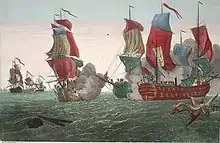
To encourage French participation in the struggle for independence, the US representative in Paris, Silas Deane promised promotion and command positions to any French officer who joined the Continental Army. Although many proved incompetent, one outstanding exception was Gilbert du Motier, Marquis de Lafayette, whom Congress appointed a major General.[179] In addition to his military ability, Lafayette showed considerable political skill in building support for Washington among his officers and within Congress, liaising with French army and naval commanders, and promoting the Patriot cause in France.
When the war started, Britain tried to borrow the Dutch-based Scots Brigade for service in America, but pro-Patriot sentiment led the States General to refuse.[180] Although the Republic was no longer a major power, prior to 1774 they still dominated the European carrying trade, and Dutch merchants made large profits shipping French-supplied munitions to the Patriots. This ended when Britain declared war in December 1780, a conflict that proved disastrous to the Dutch economy.[181] The Dutch were also excluded from the First League of Armed Neutrality, formed by Russia, Sweden and Denmark in March 1780 to protect neutral shipping from being stopped and searched for contraband by Britain and France.[182]
The British government failed to take into account the strength of the American merchant marine and support from European countries, which allowed the colonies to import munitions and continue trading with relative impunity. While well aware of this, the North administration delayed placing the Royal Navy on a war footing for cost reasons; this prevented the institution of an effective blockade and restricted them to ineffectual diplomatic protests.[183] Traditional British policy was to employ European land-based allies to divert the opposition, a role filled by Prussia in the Seven Years War; in 1778, they were diplomatically isolated and faced war on multiple fronts.[184]
Meanwhile, George III had given up on subduing America while Britain had a European war to fight.[185] He did not welcome war with France, but he believed the British victories over France in the Seven Years' War as a reason to believe in ultimate victory over France.[186] Britain could not find a powerful ally among the Great Powers to engage France on the European continent.[187] Britain subsequently changed its focus into the Caribbean theater,[188] and diverted major military resources away from America.[189]
Stalemate in the North

At the end of 1777, Howe resigned and was replaced by Sir Henry Clinton on May 24, 1778; with French entry into the war, he was ordered to consolidate his forces in New York.[190] On June 18, the British departed Philadelphia with the reinvigorated Americans in pursuit; the Battle of Monmouth on June 28 was inconclusive, but boosted Patriot morale. Washington had rallied Charles Lee's broken regiments, the Continentals repulsed British bayonet charges, the British rear guard lost perhaps 50 per-cent more casualties, and the Americans held the field at the end of the day. That midnight, the newly installed Clinton continued his retreat to New York.[191]
A French naval force under Admiral Charles Henri Hector d'Estaing was sent to assist Washington; deciding New York was too formidable a target, in August they launched a combined attack on Newport, with General John Sullivan commanding land forces.[192] The resulting Battle of Rhode Island was indecisive; badly damaged by a storm, the French withdrew to avoid putting their ships at risk.[193] Further activity was limited to British raids on Chestnut Neck and Little Egg Harbor in October.[194]
In July 1779, the Americans captured British positions at Stony Point and Paulus Hook.[195] Clinton unsuccessfully tried to tempt Washington into a decisive engagement by sending General William Tryon to raid Connecticut.[196] In July, a large American naval operation, the Penobscot Expedition, attempted to retake Maine, then part of Massachusetts, but was defeated.[197] Persistent Iroquois raids along the border with Quebec led to the punitive Sullivan Expedition in April 1779, destroying many settlements but failing to stop them.[198]
During the winter of 1779–1780, the Continental Army suffered greater hardships than at Valley Forge.[199] Morale was poor, public support fell away in the long war, the Continental dollar was virtually worthless, the army was plagued with supply problems, desertion was common, and mutinies occurred in the Pennsylvania Line and New Jersey Line regiments over the conditions in early 1780.[200]

In June 1780, Clinton sent 6,000 men under Wilhelm von Knyphausen to retake New Jersey, but they were halted by local militia at the Battle of Connecticut Farms; although the Americans withdrew, Knyphausen felt he was not strong enough to engage Washington's main force and retreated.[201] A second attempt two weeks later ended in a British defeat at the Battle of Springfield, effectively ending their ambitions in New Jersey.[202] In July, Washington appointed Benedict Arnold commander of West Point; his attempt to betray the fort to the British failed due to incompetent planning, and the plot was revealed when his British contact John André was captured and later executed.[203] Arnold escaped to New York and switched sides, an action justified in a pamphlet addressed "To the Inhabitants of America"; the Patriots condemned his betrayal, while he found himself almost as unpopular with the British.[204]
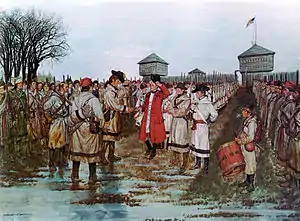
The war to the west of the Appalachians was largely confined to skirmishing and raids. In February 1778, an expedition of militia to destroy British military supplies in settlements along the Cuyahoga River was halted by adverse weather.[205] Later in the year, a second campaign was undertaken to seize the Illinois Country from the British. Virginia militia, Canadien settlers, and Indian allies commanded by Colonel George Rogers Clark captured Kaskaskia on July 4 then secured Vincennes, though Vincennes was recaptured by Quebec Governor Henry Hamilton. In early 1779, the Virginians counterattacked in the Siege of Fort Vincennes and took Hamilton prisoner. Clark secured western British Quebec as the American Northwest Territory in the Treaty of Paris concluding the war.[206]
On May 25, 1780, British Colonel Henry Bird invaded Kentucky as part of a wider operation to clear American resistance from Quebec to the Gulf coast. Their Pensacola advance on New Orleans was overcome by Spanish Governor Gálvez's offensive on Mobile. Simultaneous British attacks were repulsed on St. Louis by the Spanish Lieutenant Governor de Leyba, and on the Virginia county courthouse at Cahokia by Liutenant Colonel Clark. The British initiative under Bird from Detroit was ended at the rumored approach of Clark.[lower-alpha 22] The scale of violence in the Licking River Valley, such as during the Battle of Blue Licks, was extreme "even for frontier standards". It led to men of English and German settlements to join Clark's militia when the British and their auxiliaries withdrew to the Great Lakes.[207] The Americans responded with a major offensive along the Mad River in August which met with some success in the Battle of Piqua, but did not end Indian raids.[208]
French soldier Augustin de La Balme led Canadien militiamen in an attempt to capture Detroit, but they dispersed when Miami Indians led by Little Turtle attacked the encamped settlers on November 5.[209][lower-alpha 23] The war in the west had become a stalemate with the British garrison sitting in Detroit and the Virginians expanding westward settlements north of the Ohio River in the face of British-allied Indian resistance.[211]
War in the South

The "Southern Strategy" was developed by Lord Germain, based on input from London-based Loyalists like Joseph Galloway. They argued it made no sense to fight the Patriots in the north where they were strongest, while the New England economy was reliant on trade with Britain, regardless of who governed it. On the other hand, duties on tobacco made the South far more profitable for Britain, while local support meant securing it required small numbers of regular troops. Victory would leave a truncated United States facing British possessions in the south, Canada to the north and Ohio on their western border; with the Atlantic seaboard controlled by the Royal Navy, Congress would be forced to agree terms. However, assumptions about the level of Loyalist support proved wildly optimistic.[212]
Germain accordingly ordered Augustine Prévost, British commander in East Florida, to advance into Georgia in December 1778. Lieutenant-Colonel Archibald Campbell, an experienced officer taken prisoner earlier in the war before being exchanged for Ethan Allen, captured Savannah on December 29, 1778. He recruited a Loyalist militia of nearly 1,100, many of whom allegedly joined only after Campbell threatened to confiscate their property.[213] Poor motivation and training made them unreliable troops, as demonstrated in their defeat by Patriot militia at the Battle of Kettle Creek on February 14, 1779, although this was offset by British victory at Brier Creek on March 3.[214]
In June, Prévost launched an abortive assault on Charleston, before retreating to Savannah, an operation notorious for widespread looting by British troops that enraged both Loyalists and Patriots. In October, a joint French and American operation under Admiral d'Estaing and General Benjamin Lincoln failed to recapture Savannah.[215] Prévost was replaced by Lord Cornwallis, who assumed responsibility for Germain's strategy; he soon realised estimates of Loyalist support were considerably over-stated, and he needed far larger numbers of regular forces.[216]
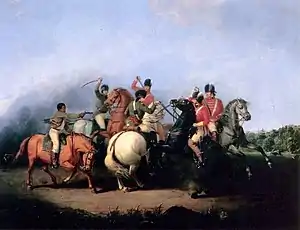
Battle of Cowpens, 1781
Reinforced by Clinton, his troops captured Charleston in May 1780, inflicting the most serious Patriot defeat of the war; over 5,000 prisoners were taken and the Continental Army in the south effectively destroyed. On May 29, Loyalist regular Banastre Tarleton defeated an American force of 400 at the Battle of Waxhaws; over 120 were killed, many allegedly after surrendering. Responsibility is disputed, Loyalists claiming Tarleton was shot at while negotiating terms of surrender, but it was later used as a recruiting tool by the Patriots.[217]
Clinton returned to New York, leaving Cornwallis to oversee the south; despite their success, the two men left barely on speaking terms, with dire consequences for the future conduct of the war.[218] The Southern strategy depended on local support, but this was undermined by a series of coercive measures. Previously, captured Patriots were sent home after swearing not to take up arms against the king; they were now required to fight their former comrades, while the confiscation of Patriot-owned plantations led formerly neutral "grandees" to side with them.[219] Skirmishes at Williamson's Plantation, Cedar Springs, Rocky Mount, and Hanging Rock signalled widespread resistance to the new oaths throughout South Carolina.[220]
In July, Congress appointed General Horatio Gates commander in the south; he was defeated at the Battle of Camden on August 16, leaving Cornwallis free to enter North Carolina.[221] Despite battlefield success, the British could not control the countryside and Patriot attacks continued; before moving north, Cornwallis sent Loyalist militia under Major Patrick Ferguson to cover his left flank, leaving their forces too far apart to provide mutual support.[222] In early October, Ferguson was defeated at the Battle of Kings Mountain, dispersing organized Loyalist resistance in the region.[223] Despite this, Cornwallis continued into North Carolina hoping for Loyalist support, while Washington replaced Gates with General Nathanael Greene in December 1780.[224]
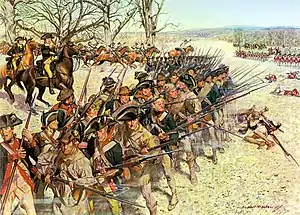
Greene divided his army, leading his main force southeast pursued by Cornwallis; a detachment was sent southwest under Daniel Morgan, who defeated Tarleton's British Legion at Cowpens on January 17, 1781, nearly eliminating it as a fighting force.[225] The Patriots now held the initiative in the south, with the exception of a raid on Richmond led by Benedict Arnold in January 1781.[226] Greene led Cornwallis on a series of counter marches around North Carolina; by early March, the British were exhausted and short of supplies and Greene felt strong enough to fight the Battle of Guilford Court House on March 15. Although victorious, Cornwallis suffered heavy casualties and retreated to Wilmington, North Carolina seeking supplies and reinforcements.[227]
The Patriots now controlled most of the Carolinas and Georgia outside the coastal areas; after a minor reversal at the Battle of Hobkirk's Hill, they recaptured Fort Watson and Fort Motte on April 15.[228] On June 6, Brigadier General Andrew Pickens captured Augusta, leaving the British in Georgia confined to Charleston and Savannah.[229] The assumption Loyalists would do most of the fighting left the British short of troops and battlefield victories came at the cost of losses they could not replace. Despite halting Greene's advance at the Battle of Eutaw Springs on September 8, Cornwallis withdrew to Charleston with little to show for his campaign.[230]
Western campaign
| Conquerors of the British Mississippi Basin |
When Spain joined France's war against Britain in 1779, their treaty specifically excluded Spanish military action in North America. However, from the beginning of the war, Bernardo de Gálvez, the Governor of Spanish Louisiana, allowed the Americans to import supplies and munitions into New Orleans, then ship them to Pittsburgh.[231] This provided an alternative transportation route for the Continental Army, bypassing the British blockade of the Atlantic Coast.[232]
The trade was organized by Oliver Pollock, a successful merchant in Havana and New Orleans who was appointed US "commercial agent".[233] It also helped support the American campaign in the west; in the 1778 Illinois campaign, militia under General George Rogers Clark cleared the British from what was then part of Quebec, creating Illinois County, Virginia.[234]
Despite official neutrality, Gálvez initiated offensive operations against British outposts.[235] First, he cleared British garrisons in Baton Rouge, Louisiana, Fort Bute, and Natchez, Mississippi, and captured five forts.[236] In doing so, Gálvez opened navigation on the Mississippi River north to the American settlement in Pittsburg.[237]
In 1781, Galvez and Pollock campaigned east along the Gulf Coast to secure West Florida, including British-held Mobile and Pensacola.[238] The Spanish operations crippled the British supply of armaments to British Indian allies, which effectively suspended a military alliance to attack settlers between the Mississippi River and Appalachian Mountains.[239][lower-alpha 24]
British defeat in America
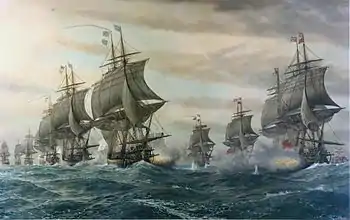
Battle of the Chesapeake, 1781
Clinton spent most of 1781 based in New York City; he failed to construct a coherent operational strategy, partly due to his difficult relationship with Admiral Marriot Arbuthnot.[240] In Charleston, Cornwallis independently developed an aggressive plan for a campaign in Virginia, which he hoped would isolate Greene's army in the Carolinas and cause the collapse of Patriot resistance in the South. This was approved by Lord Germain in London, but neither of them informed Clinton.[241]
Washington and Rochambeau now discussed their options; the former wanted to attack New York, the latter Virginia, where Cornwallis' forces were less well-established and thus easier to defeat.[242] Washington eventually gave way and Lafayette took a combined Franco-American force into Virginia,[243] but Clinton misinterpreted his movements as preparations for an attack on New York. Concerned by this threat, he instructed Cornwallis to establish a fortified sea base where the Royal Navy could evacuate his troops to help defend New York.[244]
When Lafayette entered Virginia, Cornwallis complied with Clinton's orders and withdrew to Yorktown, where he constructed strong defenses and awaited evacuation.[245] An agreement by the Spanish navy to defend the French West Indies allowed Admiral de Grasse to relocate to the Atlantic seaboard, a move Arbuthnot did not anticipate.[240] This provided Lafayette naval support, while the failure of previous combined operations at Newport and Savannah meant their co-ordination was planned more carefully.[246] Despite repeated urging from his subordinates, Cornwallis made no attempt to engage Lafayette before he could establish siege lines.[247] Even worse, expecting to be withdrawn within a few days he abandoned the outer defenses, which were promptly occupied by the besiegers and hastened British defeat.[248]
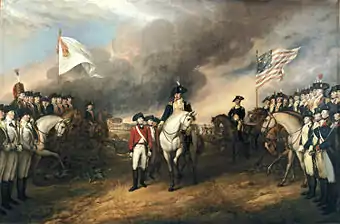
On August 31, a British fleet under Thomas Graves left New York for Yorktown.[249] After landing troops and munitions for the besiegers on August 30, de Grasse had remained in Chesapeake Bay and intercepted him on September 5; although the Battle of the Chesapeake was indecisive in terms of losses, Graves was forced to retreat, leaving Cornwallis isolated.[250] An attempted breakout over the York River at Gloucester Point failed due to bad weather.[251] Under heavy bombardment with dwindling supplies, Cornwallis felt his situation was hopeless and on October 16 sent emissaries to Washington to negotiate surrender; after twelve hours of negotiations, these were finalized the next day.[252]
Although Britain's global conflict with France and Spain continued for another two years, Yorktown was the final engagement of the American war.[253] Responsibility for defeat was the subject of fierce public debate between Cornwallis, Clinton and Germain. Despite criticism from his junior officers, Cornwallis retained the confidence of his peers and later held a series of senior government positions; Clinton ultimately took most of the blame and spent the rest of his life in obscurity.[254]
Strategy and commanders
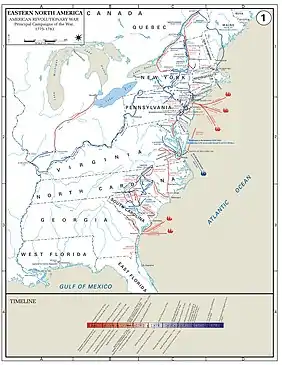
To win their insurrection, the Americans needed to outlast the British will to continue the fight. To restore empire, the British had to defeat the Continental Army in the early months, and compel the Congress to dissolve itself.[256] Historian Terry M. Mays identifies three separate types of warfare, the first being a colonial conflict in which objections to Imperial trade regulation were as significant as taxation policy. The second was a civil war with all thirteen states split between Patriots, Loyalists and those who preferred to remain neutral. Particularly in the south, many battles were fought between Patriots and Loyalists with no British involvement, leading to divisions which continued after independence was achieved.[257]
The third element was a global war between France, Spain, the Dutch Republic and Britain, with America as one of a number of different theaters.[257] After entering the war in 1778, France provided the Americans money, weapons, soldiers, and naval assistance, while French troops fought under US command in North America. While Spain did not formally join the war in America, they provided access to the Mississippi River and by capturing British possessions on the Gulf of Mexico denied bases to the Royal Navy, as well as retaking Menorca and besieging Gibraltar in Europe.[258]
Although the Dutch Republic was no longer a major power, prior to 1774 they still dominated the European carrying trade, and Dutch merchants made large profits by shipping French-supplied munitions to the Patriots. This ended when Britain declared war in December 1780 and the conflict proved disastrous to their economy.[259] The Dutch were also excluded from the First League of Armed Neutrality, formed by Russia, Sweden and Denmark in March 1780 to protect neutral shipping from being stopped and searched for contraband by Britain and France.[182] While of limited effect, these interventions forced the British to divert men and resources away from North America.[66]
American strategy
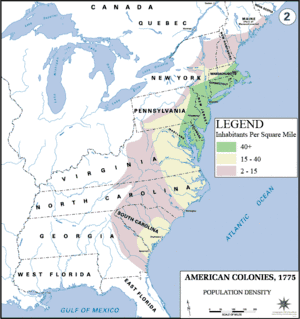
Congress had multiple advantages if the rebellion turned into a protracted war. Their prosperous state populations depended on local production for food and supplies rather than on imports from their mother country that lay six to twelve weeks away by sail. They were spread across most of the North American Atlantic seaboard, stretching 1,000 miles. Most farms were remote from the seaports, and controlling four or five major ports did not give British armies control over the inland areas. Each state had established internal distribution systems.[260]
Each former colony had a long-established system of local militia, combat-tested in support of British regulars thirteen years before to secure an expanded British Empire. Together they took away French claims in North America west to the Mississippi River in the French and Indian War. The state legislatures independently funded and controlled their local militias. In the American Revolution, they trained and provided Continental Line regiments to the regular army, each with their own state officer corps.[260] Motivation was also a major asset: each colonial capital had its own newspapers and printers, and the Patriots had more popular support than the Loyalists. British hoped that the Loyalists would do much of the fighting, but they fought less than expected.[8]
Continental Army
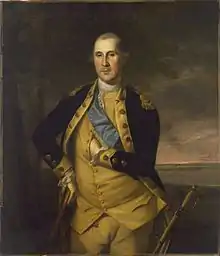
commanding the Continental Army
When the war began, Congress lacked a professional army or navy, and each colony only maintained local militias. Militiamen were lightly armed, had little training, and usually did not have uniforms. Their units served for only a few weeks or months at a time and lacked the training and discipline of more experienced soldiers. Local county militias were reluctant to travel far from home and they were unavailable for extended operations.[261] To compensate for this, Congress established a regular force known as the Continental Army on June 14, 1775, the origin of the modern United States Army, and appointed Washington as commander-in-chief. However, it suffered significantly from the lack of an effective training program and from largely inexperienced officers and sergeants, offset by a few senior officers.[262]
Each state legislature appointed officers for both county and state militias and their regimental Continental Line officers; although Washington was required to accept Congressional appointments, he was still permitted to choose and command his own generals, such as Nathanael Greene, his chief of artillery, Henry Knox, and Alexander Hamilton, the chief of staff.[263] One of Washington's most successful recruits to general officer was Baron Friedrich Wilhelm von Steuben, a veteran of the Prussian general staff who wrote the Revolutionary War Drill Manual.[262]}} The development of the Continental Army was always a work in progress and Washington used both his regulars and state militia throughout the war; when properly employed, the combination allowed them to overwhelm smaller British forces, as at Concord, Boston, Bennington, and Saratoga. Both sides used partisan warfare, but the state militias effectively suppressed Loyalist activity when British regulars were not in the area.[261][lower-alpha 25]
Washington designed the overall military strategy of the war in cooperation with Congress, established the principle of civilian supremacy in military affairs, personally recruited his senior office corps, and kept the states focused on a common goal.[266] For the first three years until after Valley Forge, the Continental Army was largely supplemented by local state militias. Initially, Washington employed the inexperienced officers and untrained troops in Fabian strategies rather than risk frontal assaults against Britain's professional soldiers and officers.[267] Over the course of the entire war, Washington lost more battles than he won, but he never surrendered his troops and maintained a fighting force in the face of British field armies and never gave up fighting for the American cause.[268]
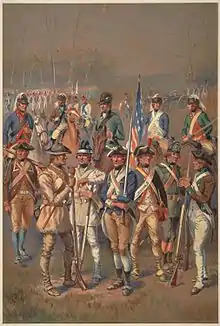
Continental Army uniforms
By prevailing European standards, the armies in America were relatively small, limited by lack of supplies and logistics; the British in particular were constrained by the difficulty of transporting troops across the Atlantic and dependence on local supplies. Washington never directly commanded more than 17,000 men,[269] while the combined Franco-American army at Yorktown was only about 19,000.[270] At the beginning of 1776, Patriot forces consisted of 20,000 men, with two-thirds in the Continental Army and the other third in the various state militias. About 250,000 men served as regulars or as militia for the Revolutionary cause over eight years during wartime, but there were never more than 90,000 men under arms at one time.[271]
As a whole, American officers never equaled their opponents in tactics and maneuvers, and they lost most of the pitched battles. The great successes at Boston (1776), Saratoga (1777), and Yorktown (1781) were won from trapping the British far from base with a greater number of troops.[263] Nevertheless, after 1778, Washington's army was transformed into a more disciplined and effective force, mostly by Baron von Steuben's training.[262] Immediately after the Army emerged from Valley Forge, it proved its ability to match the British troops in action at the Battle of Monmouth, including a black Rhode Island regiment fending off a British bayonet attack then counter-charging for the first time in Washington's army.[272] Here Washington came to realize that saving entire towns was not necessary, but preserving his army and keeping the revolutionary spirit alive was more important in the long run. Washington informed Henry Laurens[lower-alpha 26] "that the possession of our towns, while we have an army in the field, will avail them little."[274]
Although Congress was responsible for the war effort and provided supplies to the troops, Washington took it upon himself to pressure the Congress and state legislatures to provide the essentials of war; there was never nearly enough.[275] Congress evolved in its committee oversight and established the Board of War, which included members of the military.[276] Because the Board of War was also a committee ensnared with its own internal procedures, Congress also created the post of Secretary of War, and appointed Major General Benjamin Lincoln in February 1781 to the position. Washington worked closely with Lincoln to coordinate civilian and military authorities and took charge of training and supplying the army.[80][262]
Continental Navy
During the first summer of the war, Washington began outfitting schooners and other small seagoing vessels to prey on ships supplying the British in Boston.[277] Congress established the Continental Navy on October 13, 1775, and appointed Esek Hopkins as its first commander;[278] for most of the war, it consisted of a handful of small frigates and sloops, supported by numerous privateers.[279] On November 10, 1775, Congress authorized the creation of the Continental Marines, forefather of the United States Marine Corps.[265]
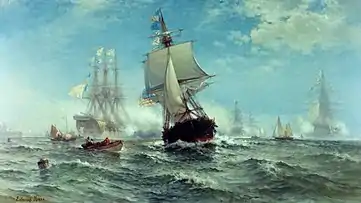
.jpg.webp) USS Alliance, Capt. Barry won the last engagement
USS Alliance, Capt. Barry won the last engagement
John Paul Jones became the first American naval hero by capturing HMS Drake on April 24, 1778, the first victory for any American military vessel in British waters.[280] The last was by the frigate USS Alliance commanded by Captain John Barry. On March 10, 1783, the Alliance outgunned HMS Sybil in a 45-minute duel while escorting Spanish gold from Havana to Congress.[281] After Yorktown, all US Navy ships were sold or given away; it was the first time in America's history that it had no fighting forces on the high seas.[282]
Congress primarily commissioned privateers to reduce costs and to take advantage of the large proportion of colonial sailors found in the British Empire. Overall, they included 1,700 ships that successfully captured 2,283 enemy ships to damage the British effort and to enrich themselves with the proceeds from the sale of cargo and the ship itself.[283][lower-alpha 27] About 55,000 sailors served aboard American privateers during the war.[10]
France
To begin with, the Americans had no major international allies, as most nation-states watched and waited to see developments unfold in British North America. Over time, the Continental Army acquitted itself well in the face of British regulars and their German auxiliaries known to all European great powers. Battles such as the Battle of Bennington, the Battles of Saratoga, and even defeats such as the Battle of Germantown, proved decisive in gaining the attention and support of powerful European nations including France and Spain, and the Dutch Republic; the latter moved from covertly supplying the Americans with weapons and supplies to overtly supporting them.[285]
The decisive American victory at Saratoga spurred France to offer the Americans the Treaty of Amity and Commerce. The two nations also agreed to a defensive Treaty of Alliance to protect their trade and also guaranteed American independence from Britain. To engage the United States as a French ally militarily, the treaty was conditioned on Britain initiating a war on France to stop it from trading with the US. Spain and the Dutch Republic were invited to join by both France and the United States in the treaty, but neither made a formal reply.[286]
On June 13, 1778, France declared war on Great Britain, and it invoked the French military alliance with the US, which ensured additional US privateer support for French possessions in the Caribbean.[lower-alpha 28] Washington worked closely with the soldiers and navy that France would send to America, primarily through Lafayette on his staff. French assistance made critical contributions required to defeat General Charles Cornwallis at Yorktown in 1781.[289][lower-alpha 29]
British strategy
- British political landscape in its 1775 American Empire[lower-alpha 30]
 The 1763 Royal Proclamation set the western boundary for the 13 Colonies
The 1763 Royal Proclamation set the western boundary for the 13 Colonies The 1768 Indian treaties: Iroquois west of the red line, Cherokees west of the purple
The 1768 Indian treaties: Iroquois west of the red line, Cherokees west of the purple
The British military had considerable experience of fighting in North America, most recently during the Seven Years' War which forced France to relinquish New France in 1763.[291] However, in previous conflicts they benefited from local logistics, as well as support from the colonial militia, which was not available in the American Revolutionary War. Reinforcements had to come from Europe, and maintaining large armies over such distances was extremely complex; ships could take three months to cross the Atlantic, and orders from London were often outdated by the time they arrived.[292]
Prior to the conflict, the colonies were largely autonomous economic and political entities, with no centralized area of ultimate strategic importance.[293] This meant that unlike Europe where the fall of a capital city often ended wars, that in America continued even after the loss of major settlements such as Philadelphia, seat of Congress, New York and Charleston.[294] British power was reliant on the Royal Navy, whose dominance allowed them to resupply their own expeditionary forces while preventing access to enemy ports. However, the majority of the American population was agrarian, rather than urban; supported by the French navy and blockade runners based in the Dutch Caribbean, their economy was able to survive.[295]
The geographical size of the colonies and limited manpower meant the British could not simultaneously conduct military operations and occupy territory without local support. Debate persists over whether their defeat was inevitable; one British statesman described it as "like trying to conquer a map".[296] While Ferling argues Patriot victory was nothing short of a miracle,[297] Ellis suggests the odds always favored the Americans, especially after Howe squandered the chance of a decisive British success in 1776, an "opportunity that would never come again".[298] The US military history speculates the additional commitment of 10,000 fresh troops in 1780 would have placed British victory "within the realm of possibility".[299]
British Army

The expulsion of France from North America in 1763 led to a drastic reduction in British troop levels in the colonies; in 1775, there were only 8,500 regular soldiers among a civilian population of 2.8 million.[300] The bulk of military resources in the Americas were focused on defending sugar islands in the Caribbean; Jamaica alone generated more revenue than all thirteen American colonies combined.[301] With the end of the Seven Years' War, the permanent army in Britain was also cut back, which resulted in administrative difficulties when the war began a decade later.[302]
Over the course of the war, there were four separate British commanders-in-chief, the first of whom was Thomas Gage; appointed in 1763, his initial focus was establishing British rule in former French areas of Canada. Rightly or wrongly, many in London blamed the revolt on his failure to take firm action earlier, and he was relieved after the heavy losses incurred at Bunker Hill.[303] His replacement was Sir William Howe, a member of the Whig faction in Parliament who opposed the policy of coercion advocated by Lord North; Cornwallis, who later surrendered at Yorktown, was one of many senior officers who initially refused to serve in North America.[304]
The 1775 campaign showed the British overestimated the capabilities of their own troops and underestimated the colonial militia, requiring a reassessment of tactics and strategy.[305] However, it allowed the Patriots to take the initiative and British authorities rapidly lost control over every colony.[306] Howe's responsibility is still debated; despite receiving large numbers of reinforcements, Bunker Hill seems to have permanently affected his self-confidence and lack of tactical flexibility meant he often failed to follow up opportunities.[307] Many of his decisions were attributed to supply problems, such as the delay in launching the New York campaign and failure to pursue Washington's beaten army.[308] Having lost the confidence of his subordinates, he was recalled after Burgoyne surrendered at Saratoga.[309]
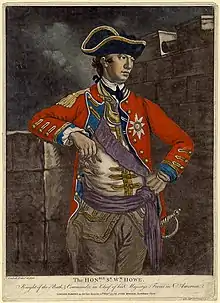
Following the failure of the Carlisle Commission, British policy changed from treating the Patriots as subjects who needed to be reconciled to enemies who had to be defeated.[310] In 1778, Howe was replaced by Sir Henry Clinton, appointed instead of Carleton who was considered overly cautious.[311] Regarded as an expert on tactics and strategy,[309] like his predecessors Clinton was handicapped by chronic supply issues.[312] As a result, he was largely inactive in 1779 and much of 1780; in October 1780, he warned Germain of "fatal consequences" if matters did not improve.[313]
In addition, Clinton's strategy was compromised by conflict with political superiors in London and his colleagues in North America, especially Admiral Mariot Arbuthnot, replaced in early 1781 by Rodney.[314] He was neither notified nor consulted when Germain approved Cornwallis' invasion of the south in 1781, and delayed sending him reinforcements believing the bulk of Washington's army was still outside New York City.[315] After the surrender at Yorktown, Clinton was relieved by Carleton, whose major task was to oversee the evacuation of Loyalists and British troops from Savannah, Charleston, and New York City.[316]
German Troops
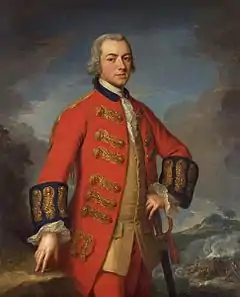
During the 18th century, all states commonly hired foreign soldiers, especially Britain; during the Seven Years' War, they comprised 10% of the British army and their use caused little debate.[317] When it became clear additional troops were needed to suppress the revolt in America, it was decided to employ mercenaries. There were several reasons for this, including public sympathy for the Patriot cause, an historical reluctance to expand the British army and the time needed to recruit and train new regiments.[318] An alternate source was readily available in the Holy Roman Empire, where many smaller states had a long tradition of renting their armies to the highest bidder. The most important was Hesse-Cassell, known as "the Mercenary State".[319]
The first supply agreements were signed by the North administration in late 1775; over the next decade, more than 40,000 Germans fought in North America, Gibraltar, South Africa and India, of whom 30,000 served in the American War.[320] Often generically referred to as "Hessians", they included men from many other states, including Hanover and Brunswick.[321] Sir Henry Clinton recommended recruiting Russian troops whom he rated very highly, having seen them in action against the Ottomans; however, negotiations with Catherine the Great made little progress.[322]
Unlike previous wars their use led to intense political debate in Britain, France, and even Germany, where Frederick the Great refused to provide passage through his territories for troops hired for the American war.[323] In March 1776, the agreements were challenged in Parliament by Whigs who objected to "coercion" in general, and the use of foreign soldiers to subdue "British subjects".[324] The debates were covered in detail by American newspapers, which reprinted key speeches and in May 1776 they received copies of the treaties themselves. Provided by British sympathisers, these were smuggled into North America from London by George Merchant, a recently released American prisoner.[325]
The prospect of mercenaries being used in the colonies bolstered support for independence, more so than taxation and other acts combined; the King was accused of declaring war on his own subjects, leading to the idea there were now two separate governments.[326][327] By apparently showing Britain was determined to go to war, it made hopes of reconciliation seem naive and hopeless, while the employment of 'foreign mercenaries' became one of the charges levelled against George III in the Declaration of Independence.[323] The Hessian reputation within Germany for brutality also increased support for the Patriot cause among German-American immigrants.[328]
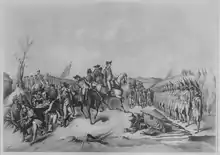
The presence of over 150,000 German-Americans meant both sides felt these mercenaries might be persuaded to desert; one reason Clinton suggested employing Russians was because he felt they were less likely to defect. When the first German troops arrived on Staten Island in August 1776, Congress approved the printing of "handbills" promising land and citizenship to any willing to join the Patriot cause. The British launched a counter-campaign claiming deserters could well be executed for meddling in a war that was not theirs.[329] Desertion among the Germans occurred throughout the war, with the highest rate of desertion occurring during the time between the surrender at Yorktown and the Treaty of Paris.[330] German regiments were central to the British war effort; of the estimated 30,000 sent to America, some 13,000 became casualties.[331]
Revolution as civil war
Loyalists
Wealthy Loyalists convinced the British government that most of the colonists were sympathetic toward the Crown;[332] consequently, British military planners relied on recruiting Loyalists, but had trouble recruiting sufficient numbers as the Patriots had widespread support.[261][lower-alpha 31] Nevertheless, they continued to deceive themselves on their level of American support as late as 1780, a year before hostilities ended.[333]
Approximately 25,000 Loyalists fought for the British throughout the war.[334] Although Loyalists constituted about twenty percent of the colonial population,[67] they were concentrated in distinct communities. Many of them lived among large plantation owners in the Tidewater region and South Carolina who produced cash crops in tobacco and indigo comparable to global markets in Caribbean sugar.[67]
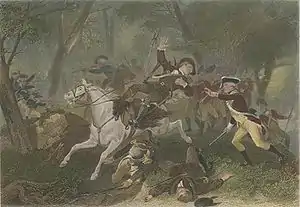
When the British began probing the backcountry in 1777–1778, they were faced with a major problem: any significant level of organized Loyalist activity required a continued presence of British regulars.[335] The available manpower that the British had in America was insufficient to protect Loyalist territory and counter American offensives.[336] The Loyalist militias in the South were constantly defeated by neighboring Patriot militia. The most critical combat between the two partisan militias was at the Battle of Kings Mountain; the Patriot victory irreversibly crippled any further Loyalist militia capability in the South.[227]
When the early war policy was administered by General William Howe, the Crown's need to maintain Loyalist support prevented it from using the traditional revolt suppression methods.[337] The British cause suffered when their troops ransacked local homes during an aborted attack on Charleston in 1779 that enraged both Patriots and Loyalists.[215] After Congress rejected the Carlisle Peace Commission in 1778 and Westminster turned to "hard war" during Clinton's command, neutral colonists in the Carolinas often allied with the Patriots whenever brutal combat broke out between Tories and Whigs.[338] Conversely, Loyalists gained support when Patriots intimidated suspected Tories by destroying property or tarring and feathering.[339]
A Loyalist militia unit—the British Legion—provided some of the best troops in British service that it received a commission in the British Army:[340] it was a mixed regiment of 250 dragoons and 200 infantry supported by batteries of flying artillery.[341][lower-alpha 32] It was commanded by Banastre Tarleton and gained a fearsome reputation in the colonies for "brutality and needless slaughter".[342] In May 1779 the British Legion was one of five regiments that formed the American Establishment.[343]
Women
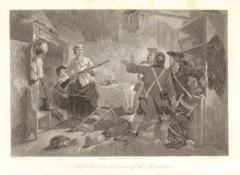
Women played various roles during the Revolutionary War; they often accompanied their husbands when permitted to do so. For example, throughout the war Martha Washington was known to visit and provide aid to her husband George at various American camps,[344] and Frederika Charlotte Riedesel documented the Saratoga campaign.[345] Women often accompanied armies as camp followers to sell goods and perform necessary tasks in hospitals and camps. They were a necessary part of eighteenth-century armies, and numbered in the thousands during the war.[346]
Women also assumed military roles: aside from auxiliary tasks like treating the wounded or setting up camp, some dressed as men to directly support combat, fight, or act as spies on both sides of the Revolutionary War.[347] Anna Maria Lane joined her husband in the Army and wore men's clothes by the time the Battle of Germantown happened. The Virginia General Assembly later cited her bravery: she fought while dressed as a man and "performed extraordinary military services, and received a severe wound at the battle of Germantown ... with the courage of a soldier".[348]
On April 26, 1777, Sybil Ludington rode to alert militia forces of Putnam County, New York, and Danbury, Connecticut, to warn them of the British's approach; she has been called the "female Paul Revere".[349] A few others disguised themselves as men. Deborah Sampson fought until her gender was discovered and discharged as a result; Sally St. Clair was killed in action during the war.[348]
African Americans
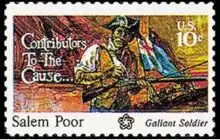
When war began, the population of the Thirteen Colonies included an estimated 500,000 slaves, predominantly used as labor on Southern plantations.[350] In November 1775, Lord Dunmore, the Royal Governor of Virginia, issued a proclamation that promised freedom to any Patriot-owned slaves willing to bear arms. Although the announcement helped to fill a temporary manpower shortage, white Loyalist prejudice meant recruits were eventually redirected to non-combatant roles. The Loyalists' motive was to deprive Patriot planters of labor rather than to end slavery; Loyalist-owned slaves were returned.[351]
The 1779 Philipsburg Proclamation issued by Clinton extended the offer of freedom to Patriot-owned slaves throughout the colonies. It persuaded entire families to escape to British lines, many of which were employed on farms to grow food for the army by removing the requirement for military service. While Clinton organized the Black Pioneers, he also ensured fugitive slaves were returned to Loyalist owners with orders that they were not to be punished for their attempted escape.[352] As the war progressed, service as regular soldiers in British units became increasingly common; black Loyalists formed two regiments of the Charleston garrison in 1783.[353]
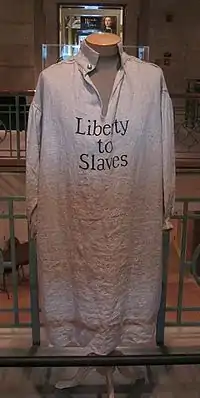
Estimates of the numbers who served the British during the war vary from 25,000 to 50,000, excluding those who escaped during wartime. Thomas Jefferson estimated that Virginia may have lost 30,000 slaves in total escapes.[354] In South Carolina, nearly 25,000 slaves (about 30 percent of the enslaved population) either fled, migrated, or died, which significantly disrupted the plantation economies both during and after the war.[355]
Black Patriots were barred from the Continental Army until Washington convinced Congress in January 1778 that there was no other way to replace losses from disease and desertion. The 1st Rhode Island Regiment formed in February included former slaves whose owners were compensated; however, only 140 of its 225 soldiers were black and recruitment stopped in June 1788.[356] Ultimately, around 5,000 African-Americans served in the Continental Army and Navy in a variety of roles, while another 4,000 were employed in Patriot militia units, aboard privateers, or as teamsters, servants, and spies. After the war, a small minority received land grants or Congressional pensions in old age; many others were returned to their masters post-war despite earlier promises of freedom.[357]
%252C_by_Jean-Baptiste-Antoine_DeVerger.png.webp)
As a Patriot victory became increasingly likely, the treatment of Black Loyalists became a point of contention; after the surrender of Yorktown in 1781, Washington insisted all escapees be returned but Cornwallis refused. In 1782 and 1783, around 8,000 to 10,000 freed blacks were evacuated by the British from Charleston, Savannah, and New York; some moved onto London, while 3,000 to 4,000 settled in Nova Scotia, where they founded settlements such as Birchtown.[358] White Loyalists transported 15,000 enslaved blacks to Jamaica and the Bahamas. The free Black Loyalists who migrated to the British West Indies included regular soldiers from Dunmore's Ethiopian Regiment, and those from Charleston who helped garrison the Leeward Islands.[353]
American Indians
Most American Indians east of the Mississippi River were affected by the war, and many tribes were divided over how to respond to the conflict. A few tribes were friendly with the colonists, but most Indians opposed the union of the Colonies as a potential threat to their territory. Approximately 13,000 Indians fought on the British side, with the largest group coming from the Iroquois tribes who deployed around 1,500 men.[20]
Indians split within languages, nations and tribes; Neutrality was impossible to maintain in the Revolution |
Early in July 1776, Cherokee allies of Britain attacked the short-lived Washington District of North Carolina. Their defeat splintered both Cherokee settlements and people, and was directly responsible for the rise of the Chickamauga Cherokee, who perpetuated the Cherokee–American wars against American settlers for decades after hostilities with Britain ended.[359]
Creek and Seminole allies of Britain fought against Americans in Georgia and South Carolina. In 1778, a force of 800 Creeks destroyed American settlements along the Broad River in Georgia. Creek warriors also joined Thomas Brown's raids into South Carolina and assisted Britain during the Siege of Savannah.[360] Many Indians were involved in the fight between Britain and Spain on the Gulf Coast and along the British side of the Mississippi River. Thousands of Creeks, Chickasaws, and Choctaws fought in major battles such as the Battle of Fort Charlotte, the Battle of Mobile, and the Siege of Pensacola.[361]
The Iroquois Confederacy was shattered as a result of the American Revolutionary War, whatever side they took; the Seneca, Onondaga, and Cayuga tribes sided with the British; members of the Mohawks fought on both side; and many Tuscarora and Oneida sided with the Americans. To retaliate against raids on American settlement by Loyalists and their Indian allies, the Continental Army dispatched the Sullivan Expedition on a punitive expedition throughout New York to cripple the Iroquois tribes that had sided with the British. Mohawk leaders Joseph Louis Cook and Joseph Brant sided with the Americans and the British respectively, which further exacerbated the split.[362]
In the western theater of the American Revolutionary War, conflicts between settlers and Indians led to lingering distrust.[363] In the 1783 Treaty of Paris, Great Britain ceded control of the disputed lands between the Great Lakes and the Ohio River, but the Indian inhabitants were not a part of the peace negotiations.[364] Tribes in the Northwest Territory joined together as the Western Confederacy and allied with the British to resist American settlement, and their conflict continued after the Revolutionary War as the Northwest Indian War.[365]
Britain's "American war" and peace
Changing Prime Ministers
|
Lord North, Prime Minister since 1770, delegated control of the war in North America to Lord George Germain and the Earl of Sandwich, who was head of the Royal Navy from 1771 to 1782. Defeat at Saratoga in 1777 made it clear the revolt would not be easily suppressed, especially after the Franco-American alliance of February 1778, and French declaration of war in June. With Spain also expected to join the conflict, the Royal Navy needed to prioritize either the war in America or in Europe; Germain advocated the former, Sandwich the latter.[366]
British negotiators now proposed a second peace settlement to Congress.[367] The terms presented by the Carlisle Peace Commission included acceptance of the principle of self-government. Parliament would recognize Congress as the governing body, suspend any objectionable legislation, surrender its right to local colonial taxation, and discuss including American representatives in the House of Commons. In return, all property confiscated from Loyalists would be returned, British debts honored, and locally enforced martial law accepted. However, Congress demanded either immediate recognition of independence, or the withdrawal of all British troops; they knew the Commission were not authorized to accept these, bringing negotiations to a rapid end.[368]
When the commissioners returned to London in November 1778, they recommended a change in policy. Sir Henry Clinton, the new British Commander-in-Chief in America, was ordered to stop treating the rebels as enemies, rather than subjects whose loyalty might be regained.[369] Those standing orders would be in effect for three years until Clinton was relieved.[370]
North backed the Southern strategy hoping to exploit divisions between the mercantile north and slave-owning south, but after Yorktown accepted this policy had failed.[371] It was clear the war was lost, although the Royal Navy forced the French to relocate their fleet to the Caribbean in November 1781 and resumed a close blockade of American trade.[372] The resulting economic damage and rising inflation meant the US was now eager to end the war, while France was unable to provide further loans; Congress could no longer pay its soldiers.[373]
On February 27, 1782 a Whig motion to end offensive war in America was carried by 19 votes.[374] North now resigned, obliging the king to invite Lord Rockingham to form a government; a consistent supporter of the Patriot cause, he made commitment to US independence a condition of doing so. George III reluctantly accepted and the new government took office on March 27, 1782; however, Rockingham died unexpectedly on July 1, and was replaced by Lord Shelburne who acknowledged American independence.[375]
American Congress signs a peace
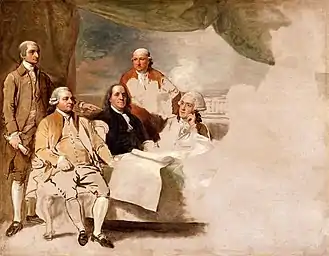
When Lord Rockingham, the Whig leader and friend of the American cause was elevated to Prime Minister, Congress consolidated its diplomatic consuls in Europe into a peace delegation at Paris. All were experienced in Congressional leadership. The dean of the delegation was Benjamin Franklin of Pennsylvania. He had become a celebrity in the French Court, but he was also an Enlightenment scientist with influence in the courts of European great powers in Prussia, England's former ally, and Austria, a Catholic empire like Spain. Since the 1760s he had been an organizer of British American inter-colony cooperation, and then a colonial lobbyist to Parliament in London. John Adams of Massachusetts had been consul to the Dutch Republic, and was a prominent early New England Patriot. John Jay of New York had been consul to Spain and was a past president of the Continental Congress. As consul to the Dutch Republic, Henry Laurens of South Carolina had secured a preliminary agreement for a trade agreement. He had been a successor to John Jay as president of Congress and with Franklin was a member of the American Philosophical Society. Although active in the preliminaries, he was not a signer of the conclusive treaty.[377]
The Whig negotiators for Lord Rockingham and his successor, Prime Minister Lord Shelburne, included long-time friend of Benjamin Franklin from his time in London, David Hartley and Richard Oswald, who had negotiated Laurens' release from the Tower of London.[377] The Preliminary Peace signed on November 30 met four key Congressional demands: independence, territory up to the Mississippi, navigation rights into the Gulf of Mexico, and fishing rights in Newfoundland.[377]
British strategy was to strengthen the US sufficiently to prevent France regaining a foothold in North America, and they had little interest in these proposals.[378] However, divisions between their opponents allowed them to negotiate separately with each to improve their overall position, starting with the American delegation in September 1782.[379] The French and Spanish sought to improve their position by creating a US dependent on them for support against Britain, thus reversing the losses of 1763.[380] Both parties tried to negotiate a settlement with Britain excluding the Americans; France proposed setting the western boundary of the US along the Appalachians, matching the British 1763 Proclamation Line. The Spanish suggested additional concessions in the vital Mississippi River Basin, but required the cession of Georgia in violation of the Franco-American alliance.[380]
Facing difficulties with Spain over claims involving the Mississippi River, and from France who was still reluctant to agree to American independence until all her demands were met, John Jay promptly told the British that he was willing to negotiate directly with them, cutting off France and Spain, and Prime Minister Lord Shelburne, in charge of the British negotiations, agreed.[381] Key agreements for America in obtaining peace included recognition of United States independence, that she would gain all of the area east of the Mississippi River, north of Florida, and south of Canada; the granting of fishing rights in the Grand Banks, off the coast of Newfoundland and in the Gulf of Saint Lawrence; the United States and Great Britain were to each be given perpetual access to the Mississippi River.[382][383]
An Anglo-American Preliminary Peace was formally entered into in November 1782, and Congress endorsed the settlement on April 15, 1783. It announced the achievement of peace with independence; the "conclusive" treaty was signed on September 2, 1783 in Paris, effective the next day September 3, when Britain signed its treaty with France. John Adams, who helped draft the treaty, claimed it represented "one of the most important political events that ever happened on the globe". Ratified respectively by Congress and Parliament, the final versions were exchanged in Paris the following spring.[384] On 25 November, the last British troops remaining in the US were evacuated from New York to Halifax.[385]
Aftermath

Washington expressed astonishment that the Americans had won a war against a leading world power, referring to the American victory as "little short of a standing miracle".[386] The conflict between British subjects with the Crown against those with the Congress had lasted over eight years from 1775 to 1783. The last uniformed British troops departed their last east coast port cities in Savannah, Charleston, and New York City, by November 25, 1783. That marked the end of British occupation in the new United States.[387]
On April 9, 1783, Washington issued orders that he had long waited to give, that "all acts of hostility" were to cease immediately. That same day, by arrangement with Washington, General Carleton issued a similar order to British troops. British troops, however, were not to evacuate until a prisoner of war exchange occurred, an effort that involved much negotiation and would take some seven months to effect.[388]
As directed by a Congressional resolution of May 26, 1783, all non-commissioned officers and enlisted were furloughed "to their homes" until the "definitive treaty of peace", when they would be automatically discharged. The US armies were directly disbanded in the field as of Washington's General Orders on Monday June 2, 1783.[389] Once the conclusive Treaty of Paris was signed with Britain, Washington resigned as commander-in-chief at Congress, leaving for his Army retirement at Mount Vernon.[377]
Territory
|
The expanse of territory that was now the United States was ceded from its colonial Mother country alone. It included millions of sparsely settled acres south of the Great Lakes Line between the Appalachian Mountains and the Mississippi River. The tentative colonial migration west became a flood during the years of the Revolutionary War. Virginia's Kentucky County counted 150 men in 1775. By 1790 fifteen years later, it numbered over 73,000 and was seeking statehood in the United States.[390]
Britain's extended post-war policy for the US continued to try to establish an Indian buffer state below the Great Lakes as late as 1814 during the War of 1812. The formally acquired western American lands continued to be populated by a dozen or so American Indian tribes that had been British allies for the most part.[364] Though British forts on their lands had been ceded to either the French or the British prior to the creation of the United States,[391] Indians were not referred to in the British cession to the US. While tribes were not consulted by the British for the treaty, in practice the British refused to abandon the forts on territory they formally transferred. Instead they provisioned military allies for continuing frontier raids and sponsored the Northwest Indian War (1785–1795). British sponsorship of local warfare on the United States continued until the Anglo-American Jay Treaty went into effect.[392][lower-alpha 36] At the same time, the Spanish also sponsored war within the US by Indian proxies in its Southwest Territory ceded by France to Britain, then Britain to the Americans.[394]
Of the European powers with American colonies adjacent to the newly created United States, Spain was most threatened by American independence, and it was correspondingly the most hostile to it.[lower-alpha 37] Its territory adjacent the US was relatively undefended, so Spanish policy developed a combination of initiatives. Spanish soft power diplomatically challenged the British territorial cession west to the Mississippi and the previous northern boundaries of the Floridas.[395] It imposed a high tariff on American goods, then blocked American settler access to the port of New Orleans. Spanish hard power extended war alliances and arms to Southwestern Indians to resist American settlement. A former Continental Army General, James Wilkinson settled in Kentucky County Virginia in 1784, and there he fostered settler secession from Virginia during the Spanish-allied Chickamauga Cherokee war. Beginning in 1787, he received pay as Spanish Agent 13, and subsequently expanded his efforts to persuade American settlers west of the Appalachians to secede from the United States, first in the Washington administration, and later again in the Jefferson administration.[395]
Casualties and losses

The total loss of life throughout the conflict is largely unknown. As was typical in wars of the era, diseases such as smallpox claimed more lives than battle. Between 1775 and 1782, a smallpox epidemic broke out throughout North America, killing an estimated 130,000 among all its populations in those revolutionary war years.[28][lower-alpha 38] Historian Joseph Ellis suggests that Washington's decision to have his troops inoculated against the disease was one of his most important decisions.[396]
Up to 70,000 American Patriots died during active military service.[397] Of these, approximately 6,800 were killed in battle, while at least 17,000 died from disease. The majority of the latter died while prisoners of war of the British, mostly in the prison ships in New York Harbor.[398][lower-alpha 39] The number of Patriots seriously wounded or disabled by the war has been estimated from 8,500 to 25,000.[400]
The French suffered 2,112 killed in combat in the United States.[401][lower-alpha 40] The Spanish lost a total of 124 killed and 247 wounded in West Florida.[402][lower-alpha 41]
A British report in 1781 puts their total Army deaths at 6,046 in North America (1775–1779).[28][lower-alpha 42] Approximately 7,774 Germans died in British service in addition to 4,888 deserters; of the former, it is estimated 1,800 were killed in combat.[405][lower-alpha 43]
Legacy
The American Revolution established the United States with its numerous civil liberties and set an example to overthrow both monarchy and colonial governments. The United States has the world's oldest written constitution, and the constitutions of other free countries often bear a striking resemblance to the US Constitution – often word-for-word in places. It inspired the French, Haitian, Latin American Revolutions, and others into the modern era.[411]
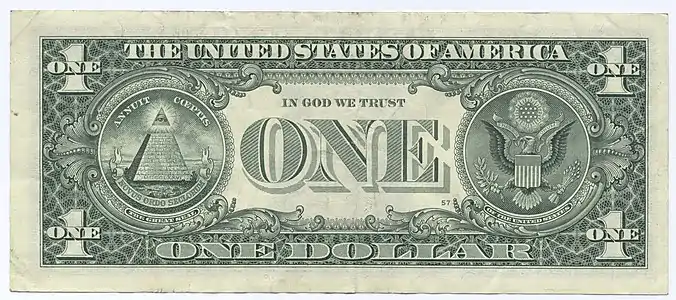
Although the Revolution eliminated many forms of inequality, it did little to change the status of women, despite the role they played in winning independence. Most significantly, it failed to end slavery which continued to be a serious social and political issue and caused divisions that would ultimately end in civil war. While many were uneasy over the contradiction of demanding liberty for some, yet denying it to others, the dependence of southern states on slave labour made abolition too great a challenge. Between 1774 to 1780, many of the states banned the importation of slaves, but the institution itself continued.[413]
In 1782, Virginia passed a law permitting manumission and over the next eight years more than 10,000 slaves were given their freedom.[414] With support from Benjamin Franklin, in 1790 the Quakers petitioned Congress to abolish slavery;[415] the number of abolitionist movements greatly increased, and by 1804 all the northern states had outlawed it.[416] However, even many like Adams who viewed slavery as a 'foul contagion' opposed the 1790 petition as a threat to the Union.[417] In 1808, Jefferson passed legislation banning the importation of slaves, but allowed the domestic slave trade to continue, arguing the federal government had no right to regulate individual states.[418]
Commemorations of the Revolutionary War
After the first U.S. postage stamp was issued in 1849 the U.S. Post Office frequently issued commemorative stamps celebrating the various people and events of the Revolutionary War. The first such stamp was the 'Liberty Bell' issue of 1926.[419]
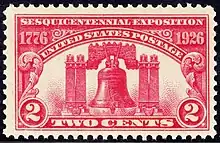 150th anniversary of American independence. Issue of 1926 |
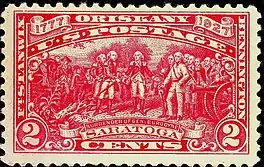 150th anniversary of Saratoga issue of 1927 |
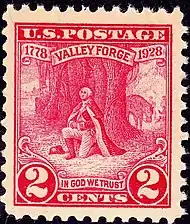 150th anniversary issue of 1928 |
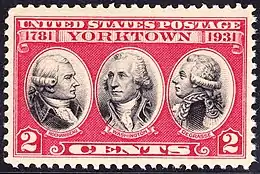 150th anniversary of Yorktown issue of 1931 |
See also
- 1776 in the United States: events, births, deaths & other years
- Timeline of the American Revolution
Topics of the Revolution
- Committee of safety (American Revolution)
- Financial costs of the American Revolutionary War
- Flags of the American Revolution
- Naval operations in the American Revolutionary War
Social history of the Revolution
- Black Patriot
- Christianity in the United States#American Revolution
- The Colored Patriots of the American Revolution
- History of Poles in the United States#American Revolution
- List of clergy in the American Revolution
- List of Patriots (American Revolution)
- Quakers in the American Revolution
- Scotch-Irish Americans#American Revolution
Others in the American Revolution
Lists of Revolutionary military
- List of American Revolutionary War battles
- List of British Forces in the American Revolutionary War
- List of Continental Forces in the American Revolutionary War
- List of infantry weapons in the American Revolution
- List of United States militia units in the American Revolutionary War
"Thirteen Colony" economy
Legacy and related
- American Revolution Statuary
- Commemoration of the American Revolution
- Independence Day (United States)
- The Last Men of the Revolution
- List of plays and films about the American Revolution
- Museum of the American Revolution
- Tomb of the Unknown Soldier of the American Revolution
- United States Bicentennial
- List of wars of independence
Bibliographies
Notes
- Peace process: March 1782 – Parliament recommends George III make peace. December 1782 – George III speech from the throne for US independence. April 1783 – Congress accepts British proposal that meets its four demands. September 1783 – conclusive treaty of peace between Britain and United States. May 1784 – Diplomats in Paris exchange the subsequent ratifications by Parliament and Congress.[1]
- (until 1779)
- The British hired over 30,000 professional soldiers from various German states who served in North America from 1775 to 1782.[5] Commentators and historians often refer to them as mercenaries or auxiliaries, terms that are sometimes used interchangeably.[6]
- (from 1779)
- Arnold served on the American side from 1775 to 1779; after defecting, he served on the British side from 1780 to 1783.
- 1780–1783
- 5,000 sailors (peak),[9] manning privateers, an additional 55,000 total sailors[10]
- British 121,000 (global 1781)[14] "Of 7,500 men in the Gibraltar garrison in September (including 400 in hospital), some 3,430 were always on duty".[15]
- Contains a detailed listing of American, French, British, German, and Loyalist regiments; indicates when they were raised, the main battles, and what happened to them. Also includes the main warships on both sides, And all the important battles.
- Royal Navy 94 ships-of-the-line global,[12] 104 frigates global,[17] 37 sloops global,[17] 171,000 sailors[18]
- Beyond the 2112 deaths recorded by the French Government fighting for American Independence, additional men died fighting Britain in a war waged by France, Spain, and the Dutch Republic from 1778 to 1784, "overseas" from the American Revolution as posited by a British scholar in his "War of the American Revolution".[25]
- Clodfelter reports that the total deaths among the British and their allies numbered 15,000 killed in battle or died of wounds. These included estimates of 3000 Germans, 3000 Loyalists and Canadians, 3000 lost at sea, and 500 American Indians killed in battle or died of wounds.[23]
- The scope of the American Revolutionary War is dated 1775–1783 between the United Colonies and the Kingdom of Great Britain; it was fought over the issue of American independence. Engagements took place in North America, the Caribbean Sea, and in the North Atlantic, specifically the North Sea, the Irish Sea, and the English Channel. Formally, the "American War" was from the Declaration of Independence by Congress addressed to Great Britain, to the September 1783 British-American Treaty of Paris to end the American Revolutionary War. Though signed on 2 September, it did not take effect until the day after "at the pleasure" of King George, at the signing of the Anglo-French Treaty of Versailles in the palace of Louis XVI; the Anglo-Spanish Treaty of Versailles followed the French. The Congress was not a signatory to either of these last two.[30]
- The colony of Georgia joined the Continental Congress later. Of interest, the Vermont Republic was independently established 1777–1791 before its admission to the US. Their Green Mountain Boys won an early engagement in May 1775 at Ticonderoga, and Ethan Allen later served as a general in the Continental Army.
- "Resolved, 4. That the foundation of English liberty, and of all free government, is a right in the people to participate in their legislative council: … they are entitled to a free and exclusive power of legislation in their several provincial legislatures, where their right of representation can alone be preserved, in all cases of taxation and internal polity, subject only to the negative of their sovereign, …: But, … we cheerfully consent to the operation of such acts of the British parliament, as are bonafide, restrained to the regulation of our external commerce, for the purpose of securing the commercial advantages of the whole empire to the mother country, and the commercial benefits of its respective members; excluding every idea of taxation internal or external, [without the consent of American subjects]." quoted from the Declarations and Resolves of the First Continental Congress October 14, 1774.
- Quebec had a largely Francophone population and had been under British rule for only 12 years. It was officially ceded in 1763 from France to Britain.
- To learn when and where the attack would occur Washington asked for a volunteer among the Rangers to spy on activity behind enemy lines in Brooklyn. Young Nathan Hale stepped forward, but he was only able to provide Washington with nominal intelligence at that time.[111] On September 21 Hale was recognized in a New York tavern and was apprehended with maps and sketches of British fortifications and troop positions in his pockets. Howe ordered that he be summarily hung as a spy without trial the next day.[112]
- Tallmadge's cover name became John Bolton, and he was the architect of the spy ring.[113]
- The American prisoners were subsequently sent to the infamous prison ships in the East River, where more American soldiers and sailors died of disease and neglect than died in every battle of the war combined.[124]
- Casualty numbers vary slightly with the Hessian forces, usually between 21 and 23 killed, 80–95 wounded, and 890–920 captured (including the wounded).[134]
- The mandate came by way of Dr. Benjamin Rush, chair of the Medical Committee. Congress had directed that all troops who had not previously survived small pox infection to be inoculated. In explaining himself to state governors, Washington lamented that he had lost "an army" to small pox in 1776 by the "Natural way" of immunity. He described the process of exposure and infection, fatality and survival, as being "the greatest calamity that can befall an Army". The American commander-in-chief began with the soldiers at Morristown and inoculated additional regiments as they were raised in New England, with the "Southern Levies" administered small pox inoculations in Philadelphia as they were marching towards the Army's encampment.[141]
- Bird's expedition numbered 150 British soldiers, several hundred Loyalists, and 700 Shawnee, Wyandot and Ottawa auxiliaries. The force skirted into the eastern regions of Patriot-conquered western Quebec that had been annexed as Illinois County, Virginia. His target was Virginia militia stationed at Lexington. As they approached downriver on the Ohio River, rumor among the Indians spread that the feared Colonel Clark had discovered their approach. Bird's Indians and Loyalists abandoned their mission 90 miles upriver to loot settlements at the Licking River. At the surrender of Ruddles Station, safe passage to families was promised, but 200 were massacred by Indian raiders. Grenier maintains that "The slaughter the Indians and rangers perpetrated was unprecedented".
- Most American Indians living in the area remembered the French better than any of the British they had met. Despite the British military nearby, the Miami people sought to avoid fighting with either Virginian Clark or Frenchman La Balme. On La Balme's horseback advance onto Detroit, he paused two weeks to ruin a local French trader and loot surrounding Miami towns. La Balme might have treated with them as allies, but he pushed Little Turtle into warrior leadership, converting most Miami tribes into British military allies, and launching the military career of one of the most successful opponents of westward settlement over the next thirty years.[210]
- Governor Bernardo de Gálvez is only one of eight men made honorary US citizens for his service in the American Cause. see Bridget Bowman (29 December 2014). "Bernardo de Gálvez y Madrid's Very Good Year". Roll Call. The Economist Group. Retrieved April 25, 2020.
- Three branches of the United States Military trace their roots to the American Revolutionary War; the Army comes from the Continental Army; the Navy comes from the Continental Navy, appointing Esek Hopkins as the Navy's first commander.[264] The Marine Corps links to the Continental Marines, created by Congress on November 10, 1775.[265]
- Laurens was president of the Second Continental Congress at this time.[273]
- In what was known as the Whaleboat War, American privateers mainly from New Jersey, Brooklyn and Connecticut attacked and robbed British merchant ships and raided and robbed coastal communities of Long Island reputed to have Loyalist sympathies.[284]
- King George III feared that the war's prospects would make it unlikely he could reclaim the North American colonies.[287] During the later years of the Revolution, the British were drawn into numerous other conflicts about the globe.[288]
- The final elements for US victory over Britain and US independence was assured by direct military intervention from France, as well as ongoing French supply and commercial trade over the final three years of the war.[290]
- The Indian treaties mapped are from 1778; the subsequent 1770 Treaty of Lochaber surrendered additional Cherokee lands in southwestern West Virginia.
- On militia see Boatner 1974, p. 707;
Weigley 1973, ch. 2 - "British Legion Infantry strength at Cowpens was between 200 and 271 enlisted men". However, this statement is referenced to a note on pp. 175–76, which says, "The British Legion infantry at Cowpens is usually considered to have had about 200–250 men, but returns for the 25 December 1780 muster show only 175. Totals obtained by Cornwallis, dated 15 January, show that the whole legion had 451 men, but approximately 250 were dragoons". There would therefore appear to be no evidence for putting the total strength of the five British Legion light infantry companies at more than 200.[341]
- The Treaty of Paris covers the Anglo-American Preliminary Treaty in November 1782, and its conclusive treaty September 1783. Also covered: European diplomatic history at Peace of Paris (1783) for preliminary British treaties signed at Paris in January 1783 with France 1783; Spain 1783 with their respective conclusive treaties signed at Versailles September 1783; British preliminary treaty with the Dutch Republic in September 1783 at Paris, then conclusively signed in May 1784.
- Painting never completed because the British commissioners refused to pose. Laurens, pictured, was actually in London at the time the picture was being painted.[376]
- St. Paul's Chapel is shown on the left. However, the parade route in 1783 did not pass by it, but went from Bull's Head Tavern on Bowery near Bayard, then continuing down Chatham, Pearl, Wall, and ending at Cape's Tavern on Broadway.
- For the thirteen years prior to the Anglo-American commercial Jay Treaty of 1796 under President John Adams, the British maintained five forts in New York state: two forts at northern Lake Champlain, and three beginning at Fort Niagara stretching east along Lake Ontario. In the Northwest Territory, they garrisoned Fort Detroit and Fort Michilimackinac.[393]
- There had been native-born Spanish (hidalgo) uprisings in several American colonies during the American revolution, contesting mercantilist reforms of Carlos III that had removed privileges inherited from the Conquistadors among encomiendas, and they also challenged Jesuit dominance in the Catholic Church there. American ship captains were known to have smuggled banned copies of the Declaration of Independence into Spanish Caribbean ports, provoking Spanish colonial discontent.
- In addition to as many as 30% deaths in port cities, and especially high rates among the closely confined prisoner-of-war ships, scholars have reported large numbers lost among the Mexican population, and large percentage losses among the American Indian along trade routes, Atlantic to Pacific, Eskimo to Aztec.
- If the upper limit of 70,000 is accepted as the total net loss for the Patriots, it would make the conflict proportionally deadlier than the American Civil War.[7] Uncertainty arises from the difficulties in accurately calculating the number of those who succumbed to disease, as it is estimated at least 10,000 died in 1776 alone.[399]
- Elsewhere around the world, the French lost another approximately 5,000 total dead in conflicts 1778–1784.[401]
- During the same time period in the Fourth Anglo-Dutch War, the Dutch suffered around 500 total killed, owing to the minor scale of their conflict with Britain.[402]
- British returns in 1783 listed 43,633 rank and file deaths across the British Armed Forces.[403] In the first three years of the Anglo-French War (1778), British list 9,372 soldiers killed in battle across the Americas; and 3,326 in the West Indies (1778–1780).[28] In 1784, a British lieutenant compiled a detailed list of 205 British officers killed in action during British conflicts outside of North America, encompassing Europe, the Caribbean and the East Indies.[404] Extrapolations based upon this list puts British Army losses in the area of at least 4,000 killed or died of wounds outside of its North American engagements.[405]
- Around 171,000 sailors served in the Royal Navy during British conflicts worldwide 1775–1784; approximately a quarter of whom had been pressed into service. Around 1,240 were killed in battle, while an estimated 18,500 died from disease (1776–1780).[406] The greatest killer at sea was scurvy, a disease caused by vitamin C deficiency.[407] It was not until 1795 that scurvy was eradicated from the Royal Navy after the Admiralty declared lemon juice and sugar were to be issued among the standard daily grog rations of sailors.[408] Around 42,000 sailors deserted worldwide during the era.[409] The impact on merchant shipping was substantial; 2,283 were taken by American privateers.[283] Worldwide 1775–1784, an estimated 3,386 British merchant ships were seized by enemy forces during the war among Americans, French, Spanish, and Dutch.[410]
- The U.S. motto "A New Age Now Begins" is a paraphrase from Thomas Paine's pamphlet Common Sense, "We have it in our power to begin the world over again."[412]
Citations
- Year dates enclosed in [brackets] denote year of original printing
- Maryland State Archives, MSA SC 1556-40, 2007
- Simms 2009, pp. 615–618
- Bell 2015, Essay
- Atwood 2000, pp. 1, 23
- Lowell 1884, pp.14–15
- Atwood 2002, pp. 1, 23
- Duncan, L. 1931, p. 371
- Lanning 2009, pp.195–196
- Greene & Pole 2008, p. 328
- U.S. Merchant Marine 2012, "Privateers and Mariners"
- Paullin 1906, pp. 315–316
- Dull 1987, p. 110
- "Red Coats Facts", Totally History.com 2012
- Rinaldi, "British Army 1775–1783"
- Chartrand 2006, p. 63
- Savas & Dameron 2006, p. xli
- Winfield 2007
- Mackesy 1993 [1964] , pp. 6, 176
- Knesebeck 2017 [1845], p. 9
- Greene & Pole 2008, p. 393
- Burrows 2008, "Patriots or Terrorists"
- Peckham (ed.) 1974
- Clodfelter 2017, pp. 133–134
- Rignault 2004, p. 20, 53
- Clodfelter 2017, p. 135, p.75
- Otfinoski 2008, p. 16
- Archuleta 2006, p. 69
- Clodfelter 2017, p 134
- Burrows 2008, "Forgotten Patriots"
- Wallace 2015, "American Revolution"
- O'Shaughnessy 2013, p. 179.
- Calloway 2007, p. 4
- Calloway 2007, pp.14–15
- Calloway 2007, p.12
- Bellot 1960, pp. 73–77
- Watson and Clark 1960, pp. 183–184
- Watson and Clark 1960, p. 187, 116
- Morgan 2012, p.40
- Ferling 2007, p.23
- Morgan 2012, p.52
- Greene & Pol 2008, pp. 155–156
- Ammerman 1974, p 15
- Olsen 1992, pp. 543–544
- Ferling 2003, p. 112
- Ferling 2015, p. 102
- Greene and Pole 2008, p. 199
- Paine, Kramnick (Ed.) 1982, p. 21
- Ferling 2007, pp. 62–64
- Axelrod 2009, p. 83
- Fischer, D. 2004, p. 76
- O'Shaughnessy 2013, p. 25
- Brown 1941, pp. 29–31
- Ketchum 2014a, p. 211
- Maier 1998, p. 25
- Ferling 2003, pp. 123–124
- Lecky 1892, vol. 3, pp. 162–165
- Davenport 1917, pp. 132–144
- Smith, D. 2012, pp. 21–23
- Miller, J. 1959, pp. 410–12
- Maier 1998, pp. 33–34
- McCullough 2005, pp.119–122
- Ferling 2007, pp. 112, 118
- Maier 1998, pp. 160–61
- Fischer, D. 2004, p. 29
- Mays 2019, p. 2
- Mays 2019, p. 3
- Greene & Pole 2008, p. 235
- CIA 2007, "Intelligence Until WWII"
- Rose A. 2014 [2006], p. 43
- Mays 2019, p. 8
- Ferling 2007, pp.129–19
- Ketchum 2014a, pp. 18, 54
- Ketchum 2014a, pp. 2–9
- Higginbotham 1983 [1971], pp. 75–77
- Ketchum 2014a, pp. 183, 198–209
- Rankin 1987, p. 63
- Chernow, 2010, p. 186
- Chernow, 2010, p. 187
- Taylor 2016, pp. 141–142
- Bell 2005, pp. 3–4
- Lecky 1892, vol. 3, pp. 449–450
- McCullough 2005, p. 53
- Frothingham 1903, pp. 100–101
- Ferling 2003, p. 183
- Alden 1969, pp. 188–190
- Smith, J. 1907 vol 1, p. 293
- Glatthaar 2007, p. 91, 93
- Greene & Pole 2008, pp. 504–505
- Randall 1990, pp. 38–39
- Lanctot 1967, pp. 141–46
- Stanley 2006, pp. 127–28
- Smith, J. 1907 vol 1, p. 242
- Watson and Clark 1960, p.203
- Lefkowitz 2007, pp. 264–265
- Smith, J. 1907, vol 2, pp. 459–552
- Selby 2007, p. 2
- Levy 2007, p. 74
- Russell 2000, p. 73
- McCrady 1901, p. 89
- Landrum 1897, pp. 80–81
- Wilson 2005, p. 33
- Hibbert 2008, p. 106
- Bicheno 2014, pp. 154, 158
- Field 1898, p. 104
- McCusker 1997, pp. 185–87
- Field 1898, pp. 117–18
- Field 1898, pp. 120–25
- Fischer, D. 2004, p. 78-76
- Ketchum 2014 [1973], p. 104
- Johnston 1897, p. 61
- Burke 1975, p. 134
- Baker 2014, Chap.11
- Baker 2014, Chap.12
- CIA 2011, Historical Document
- Fischer, D. 2004, p. 89, 381
- Adams 1963 [1895-6], p. 657
- McCullough 2005. pp. 184–186
- McGuire 2011, pp. 165–166
- Fischer, D. 2004, pp. 102–107
- Fischer, D. 2004, pp. 102–111
- Ketchum 2014 [1973], pp. 111, 130
- Fischer, D. 2004, pp. 109–25
- McCullough 2005, p. 122
- Lowenthal 2009, pp. 61, 131
- Tucker 2002, pp.22–23
- Schecter 2003, pp. 266–67
- Fischer, D. 2004, p. 138-142
- Morris, R.B. Morris 1983 [1965] , p. 139
- McCullough 2005, p. 195
- Ketchum 2014 [1973], pp. 191, 269
- Adams 1963 [1895-6], pp. 650–670
- Schecter 2003, pp. 259–63
- Fischer, D. 2004, pp. 206–159
- Fischer, D. 2004, p. 254
- Wood 1995, pp. 72–74
- Mauch 2003, p. 416
- Fischer, D. 2004, p. 307
- McCullough 2005, p. 290
- Lengel 2005, p. 208
- Washington 1932, "Writings" v.7, p. 38, 130–131
- Washington 1932, "Writings" v.7, p. 131, 130
- Fischer, D. 2004, pp. 345–358
- Lecky 1891 Vol.4, p.57
- Ketchum 1997, pp.79–80
- Ketchum 1997, pp.81–82
- Ketchum 1997, p.84
- Ketchum 1997, pp.85–86
- Ketchum 1997, pp. 244–249
- Gabriel 2012, p. x
- Ketchum 1997, p. 332
- Ketchum 1997, pp. 337–339
- Ketchum 1997, pp. 368–369
- Ferling, 2007, pp.238–239
- Ketchum 1997, pp. 421–424
- Stedman 1794, Vol. 1, pp. 317–319
- Adams 1911, p. 43
- Ward, C. 1952, pp. 361–362
- Taaffe 2003, pp. 95–100
- Daughan, 2011, pp. 148–155
- McGeorge, 1905, pp. 4–8
- Cadwalader 1901, p. 20
- Cadwalader 1901, pp. 22
- Cadwalader 1901, pp. 22, 27
- Fiske 1891, p. 332
- Chernow 2010 (2011), pp. 327–328
- Lockhart 2008, p.?
- Risch, 1981, pp. 322, 417–418
- Ferling 2007, p.117
- Jones 2002, pp. 5–6
- Ferling 2007, pp.117–119
- Chambers 1999
- Chambers 2004
- Eclov 2013 pp.23–24
- Stockley 2001, pp. 11–14
- Renouf, Stephen. "Spain in the American Revolution" (PDF). Spain Society; SAR. sar.org. Retrieved December 7, 2020.
- Davenport 1917, pp. 145–146
- Davenport 1917, p. 146
- Weeks 2013, p. 27
- Ferling 2007, p. 283
- Edler 2001 [1911], pp. 28–32
- Scott 1988, pp. 572–573
- Grainger 2005, p. 10
- Syrett 1998, p. 2
- Syrett 1998, pp. 18–19
- Ferling 2007, p. 294
- Syrett 1998, p. 17
- Scott 1990, pp. 264–272
- Syrett 1998, p. 18
- Higginbotham 1983 [1971], pp. 175–188
- Higginbotham 1983 [1971], pp. 175–88
- Chernow 2010 (2011), p.343
- Morrissey 2004, pp. 77–78
- Daughan 2011 [2008], pp. 174–176
- Goos, www.sar.org/wp-content/uploads/2020/06/Battle-at-Chestnut-Neck-by-Norman-Goos.pdf
- Hazard 1829, p. 54
- Nelson 1999, p. 170
- Bicheno 2014, p. 149
- Fischer, J. 2008, p. 86
- Tolson 2008, "Washington's Savvy Won the Day"
- Chandler 2017, pp. 363–380
- Fleming 2005 [1973], pp. 174–175
- Fleming 2005 [1973], pp. 232, 302
- Palmer 2010, p. 340–342
- Palmer 2010, pp.376–377
- Nester 2004, p. 194
- Harrison 2001, pp. 58–60
- Grenier 2005, p. 159
- Nelson 1999, p. 118
- Gaff 2004, p. 85
- Hogeland 2017, p. 88-89
- Skaggs 1977, p. 132
- Pearson 1993, pp.16–19
- Wilson 2005, p.87
- Morrill 1993, pp.46–50
- Wilson 2005, p. 112
- Pearson 1993, pp.22–23
- Piecuch 2004, pp.4–8
- Borick 2003, pp.127–128
- Gordon and Keegan 2007, p.101-102
- Gordon and Keegan 2007, pp.88–92
- Rankin 2011 [1996], p.
- Buchanan 1997, p. 202
- Ferling, 2007, pp. 459–461
- Buchanan 1997, p. 275
- Golway 2005, p. 238-242
- Peterson 1975 [1970], pp. 234–238
- Buchanan 1997, p. 241
- Greene, F. 1913, pp. 234–237
- Reynolds 2012, pp. 255–277
- Pancake 1985, p. 221
- Narrett 2015, p.81
- Chavez 2002, p.108
- Narrett 2015, p.71
- Butterfield 1903, p.123-124
- Chávez 2002, p. 170
- Don Jaun Carlos I 1979, speech
- Deane 2018, "Spanish New Orleans helped America"
- Raab 2007, p. 135
- O'Brien 2008, p. 124
- Ferling 2007, p.444
- Ketchum 2014b, pp. 423, 520
- Ketchum 2014b, p. 139
- Ferling 2007, pp.526–529
- Grainger 2005, pp. 43–44
- Taylor 2016, pp. 293–295
- Dull 2015 [1975] , pp. 247–248
- Ketchum 2014b, p. 205
- Lengel 2005, p. 337
- Middleton 2014, pp. 29–43
- Black 1992, p. 110
- Dale 2005, pp.36–37
- Ferling 2007, pp. 534–535
- Grainger 2005, p. 1
- Middleton 2014, pp. 370–372
- USMA History Dept., Map: "American Revolution Principal Campaigns"
- Mays 2019, pp. 1–2
- Mays 2019, p. 2-3
- Davenport 1917, p. 168
- Scott 1988, pp. 572–573
- Greene and Pole 2008, pp. 36–39
- Black 2001 [1991], p. 59
- Ferling 2007, pp. 286–287
- Higginbotham 1987, Chap.3
- Miller 1997, pp. 11–12, 16
- Smith, D. 2012, pp. iv, 459
- Lengel 2005, pp. 365–71
- Ellis 2004, pp. 92–109
- Rose, A. 2014 [2006], pp. 258–261
- Boatner 1974, p. 264
- Duffy 2005 [1987], p. 13
- Crocker 2006, p. 51
- Ferling 2007, pp. 294–295
- Jillson and Wilson, 1994, p. 77
- Chernow, 2010, p. 344
- Carp 1990, p. 220
- Freeman and Harwell (ed.), p. 42
- Ferling 2007, p. 360
- Miller 1997 [1977], pp. 11–12, 16
- Higginbotham 1983 [1971], pp. 331–46
- Higginbotham 1983 [1971], pp. 331–46
- Thomas 2017, "Last Naval Battle"
- Daughan 2011 [2008], p. 240
- Pike 1907, "Privateers"
- Philbrick 2016, p. 237
- Trevelyan 1912a, p. 249
- Morgan 2012 [1956], pp.82–83
- Ketchum 1997, p. 447
- Ketchum 1997, pp. 405–48
- Davis 1975, pp. 203, 303, 391
- Higginbotham 1983 [1971], pp. 188–98
- Cave 2004, p. 21-22
- Greene and Pole 2008, pp. 298, 306
- Rossman 2016, p. 2
- Curtis 1926, pp. 148–149
- Greene and Pole 2008, pp. 42, 48
- Curtis 1926, p. 148
- Ferling 2007, pp. 562–77
- Ellis 2013, p. xi
- Stewart, R. 2005, vol. 4, p. 103
- Clode 1869, Vol. 1, p. 268
- Billias 1969, p. 83
- Clayton 2014, p. 65
- O’Shaunessy 2013, p. 86
- Ketchum 1997, p. 76
- Ketchum 2014a, p.208
- Miller 1959, p. 410–12
- Fleming 2006, p.44
- Davies, K. 1972, vol. 12-1776, 5:93, Howe to Germain, June 7 and July 7, 1776
- O’Shaunessy 2013, p. 216
- Hibbert 2000, p. 160-161
- O’Shaunessy 2013, p.
- Davies, K. 1972, vol. 15-1778, 5:96, Clinton to Germain, September 15, 1778
- Davies, K. 1972, vol. 18-1780, 5:100, Clinton to Germain, October 31, 1780
- Ferling 2007, p. 444
- Ketchum 2014b, p. 208–210
- Cashin 2005, "Revolutionary War in Georgia"
- Baer 2015, p.115
- Baer 2015, p.117
- Showalter 2007, "Best armies money could buy"
- Baer 2015, pp.111–112
- Fetter 1980, p. 508
- Baer 2015, pp.118–119
- Schmidt 1958, pp. 208–209
- Baer 2015, pp. 121, 141–142
- Baer 2015, pp.143–144
- Baer 2015, pp. 136–143
- O'Saughnessy, 2004, p. 20
- Baer 2015, p.142
- Mauch 2003, p. 415
- Atwood, 2002, p. 194
- Lowell 1884, pp. 20–21, 282–283
- Ritcheson 1973, p. 6
- Lecky 1892 vol. 3, p. 139
- Savas and Dameron 2006, p.xli
- Black 2001 [1991], p. 12
- Black 2001 [1991], p. 13-14
- Black 2001 [1991], p. 14
- Black 2001 [1991], pp. 14–16; pp. 35, 38; p. 16
- Calhoon 1973, p.
- Buchanan 1997, p. 327
- Babits 2011, p. 41
- Bass 1957, pp. 548–550
- Katcher 1973, p. 101
- Chernow, 2010, p. 215
- Berkin 2005, p. 84
- Dunkerly 2014, "Camp Followers"
- Howat 2017, "Women Spies"
- Historical Essay 2009
- Hunt 2015, pp. 188–222
- Nash 2012, p. 251
- Nash, 2005, pp. 167–168
- Canada’ Digital Collections "Black Loyalists"
- Bibko, 2016, pp. 68–69
- Bibko, 2016, p. 59
- Kolchin 1994, p. 73
- lanning, 2012, p.75
- Alexander 2010, p. 356
- Bibko, 2016, p. 61
- Finger 2001, pp. 43–64
- Ward, H. 1999, p. 198
- O'Brien 2008, pp. 123–126
- Ferling 2007, pp. 200–203
- Reid, D. 2017, p.
- Carroll 2001, p. 24
- Ferling 2007, pp. 354–355
- Syrett 1998, pages 18–22
- Hibbert 2000, p. 160
- Whiteley 1996, p. 175
- Hibbert 2000, p. 160–61
- Greene & Pole 2008, p. 325
- Hibbert 2008, p. 333
- Davis, L. and Engerman 2006, p. 64
- Rappleye 2010, pp. 300–313
- Namier and Brooke 1985, p. 246
- Ward and Prothero 1925, p. 458
- Morris, R.B. Morris 1983 [1965] , pp. 435–436
- Ferling 2003, pp. 378–379
- Black 2011, pp.117–18
- Harvey 2004, pp. 531–32
- Cogliano 2003, p. 85
- Morris, 1983 [1965] , pp. 221–323, 331–333
- Dull, 1987 [1975] , pp. 144–151
- Morris, 1983 [1965] , pp. 218–221
- Kaplan, L. 1983, "Treaty of Paris"
- Ketchum 2014b, p. 287
- Ferling 2007, p. 562
- Ferling 2007, pp. 557–558
- Ferling 2007, p. 553
- Armour 1941, p. 350
- Herring 2011 [2008], p 41
- Treaty of Greenville 1795, U.S. Congress and "Tribes Northwest of the Ohio River"
- Benn 1993, p. 17
- Herring 2011 [2008], p 45
- Herring 2011 [2008], p 41
- Herring 2011 [2008], p 46
- Ellis 2004, p. 87
- Peckham 1974, p.
- Burrows 2008, p.
- Duncan 1931, p.371
- Chambers 1999 p. 849
- Dawson 2017, "Frenchmen who died"
- White 2010, "Essay"
- Burke 1785, p.
- Inman 1903, pp.203–205
- Duncan, L. 1931
- Debret 1781, p. pp. 269
- NIH GARD 2016, "Scurvy"
- Vale 2013, p.160
- Mackesy 1993 [1964], pp. 6, 176
- Conway 1995, p. 191
- Bailyn, 2007, pp. 35, 134–49
- McDonald, Forrest. Novus Ordo Seclorum: The Intellectual Origins of the Constitution, pp. 6–7, University Press of Kansas, Lawrence, Kansas, 1985. ISBN 0-7006-0284-4.
- Morgan, 2012 [1956] , pp. 96–97
- Morgan, 2012 [1956] , p. 97
- Middlekauff, 2007, [1982], p. 557
- Wood, 1992, pp. 3–8, 186–7
- Wood, 2017, p. 348
- Wood, 2017, p. 416
- Houseman; Kloetzel (2019). Scott 2019 Specialized Catalogue of United States Stamps and Covers. Amos Media Company. ISBN 9780894875595.
Stamps listed in chronological order
Bibliography
- Abrams, Creighton W. "The Yorktown Campaign, October 1781". National Museum, United States Army, Army Historical Foundation. Retrieved May 20, 2020.
- Adams, Charles Francis (1911). Proceedings of the Massachusetts Historical Society: Campaign of 1777. 44. Massachusetts Historical Society.
- —— (1963) [1895–1896]. Jameson, J. Franklin (ed.). The American historical review. New York, N.Y. : Kraus Reprints.
- —— (1969). A History of the American Revolution. Knopf Doubleday Publishing Group. ISBN 978-0-306-80366-6.
- Alden, John R. (1976). American Revolution, Seventeen Seventy Five to Seventeen Eighty-Three. Harper Collins. ISBN 978-0061330117.
- —— (2010). Encyclopedia of African American History. ABC-CLIO. p. 356. ISBN 978-1-85109-774-6.
- Allison, David K; Ferreiro, Larrie D., eds. (2018). The American Revolution: A World War. Smithsonian Institution. ISBN 978-1-5883-4659-9.
- Ammerman, David (1974). In the Common Cause: American Response to the Coercive Acts of 1774. New York: Norton. ISBN 978-0-8139-0525-9.
- Armour, Alexander W. (October 1941). "Revolutionary War Discharges". William and Mary Quarterly. Omohundro Institute of Early American History and Culture. 21 (4): 344–360. doi:10.2307/1920145. JSTOR 1920145.
- Archuleta, Roy A. (2006). Where We Come from. p. 69. ISBN 978-1-4243-0472-1.
- Atwood, Rodney (2002). The Hessians: Mercenaries from Hessen-Kassel in the American Revolution. Cambridge University Press. ISBN 978-0521526371.
- Axelrod, Alan (2009). The Real History of the American Revolution: A New Look at the Past. Sterling Publishing Company, Inc. ISBN 978-1-4027-6816-3.
- Babits, Lawrence E. (2011). A Devil of a Whipping: The Battle of Cowpens. University of North Carolina Press. ISBN 978-0-8078-8766-0.
- Stone, Bailey (1994). The Genesis of the French Revolution: A Global Historical Interpretation. ISBN 978-0-5214-4570-2.
- Bailyn, Bernard (2007). To Begin the World Anew: The Genius and Ambiguities of the American Founders. Knopf Doubleday Publishing Group. ISBN 978-0-3074-2978-0.
- Baer, Friederike (Winter 2015). "The Decision to Hire German Troops in the War of American Independence: Reactions in Britain and North America, 1774–1776". Early American Studies. University of Pennsylvania Press. 13 (1): 111–150. doi:10.1353/eam.2015.0003. JSTOR 24474906. S2CID 143134975.
- Baker, Mark Allen (2014). Spies of Revolutionary Connecticut: From Benedict Arnold to Nathan Hale. Charleston, South Carolina: The History Press. ISBN 978-1-62619-407-6.
- Bass, Robert D. (October 1957). "The Green Dragoon: The Lives of Banastre Tarleton and Mary Robinson". The North Carolina Historical Review. North Carolina Office of Archives and History. 34 (4): 548–550. JSTOR 23517100.
- Belcher, Henry (1911). The first American Civil War, first period 1775–1778. 1. London, MacMillan.
- Bell, William Gardner (2005). Commanding Generals and Chiefs of Staff, 1775–2005: Portraits & Biographical Sketches of the United States Army's Senior Officer. ISBN 978-0-1608-7330-0.
- Bellot, LJ (1960). Canada v Guadeloupe in Britain's old colonial empire: the Peace of Paris of 1763 (PDF) (PhD). Rice Institute.
- Bemis, Samuel Flagg; Ferrell, Robert H. (1958). The American Secretaries of State and Their Diplomacy. Pageant Book Company.
- Benn, Carl (1993). Historic Fort York, 1793–1993. Toronto: Dundurn Press Ltd. 1. ISBN 0920474799.
- Berkin, Carol (2005). Revolutionary Mothers. Women in the Struggle for America's Independence. New York: Alfred A. Knopf. ISBN 1-4000-4163-5.
- Bibko, Julia (2016). "The American Revolution and the Black Loyalist Exodus". History: A Journal of Student Research.
- Bicheno, Hugh (2014). Rebels and Redcoats: The American Revolutionary War. HarperCollins. ISBN 978-0-0073-9091-5.
- Billias, George Athan (1969). George Washington's Opponents: British Generals and Admirals in the American Revolution. University of California.
- Black, Jeremy (1992). "Naval Power, Strategy and Foreign Policy, 1775–1791". In Michael Duffy (ed.). Parameters of British Naval Power, 1650–1850. Exeter, UK: University of Exeter Press. pp. 95–120, here: 105. ISBN 978-0-85989-385-5.
- —— (2001) [1991]. War for America: The Fight for Independence, 1775–1783. Sutton Publishing. ISBN 978-0750928083.
- —— (2011). Fighting for America: The Struggle for Mastery in North America, 1519–1871. Indiana University Press. ISBN 9780253005618.
- Boatner, Mark M. (1974) [1966]. Encyclopedia of the American Revolution'. D. McKay Company. ISBN 978-0-6795-0440-5.
- Borick, Carl P. (2003). A Gallant Defense: the Siege of Charleston, 1780. University of South Carolina Press. ISBN 978-1-57003-487-9. OCLC 5051139.
- Brown, Weldon A (1941). Empire Or Independence A Study in the Failure Of Reconciliation 1774-1783. Kennikat Press.
PDF file available for download
- Buchanan, John (1997). The Road to Guilford Courthouse: The American Revolution in the Carolinas. John Wiley & Sons. ISBN 978-0-4711-6402-9.
- —— (1860). O'Callaghan, E. B. (ed.). Orderly book of Lieut. Gen. John Burgoyne, from his entry into the state of New York until his surrender at Saratoga, 16th Oct. 1777. Albany, N.Y., J. Munsell.
- Burke, Edmond, ed. (1785). Annual Register: World Events, 1783. London: Jay Dodsley.
- Burrows, Edwin G. (Fall 2008). "Patriots or Terrorists". American Heritage. 58 (5). Archived from the original on March 23, 2013. Retrieved November 29, 2014.
- —— (2008). Forgotten Patriots: The Untold Story of American Prisoners During the Revolutionary War. Basic Books. New York. ISBN 978-0-7867-2704-9.
- Butterfield, Consul W. (1903). History of George Rogers Clark's Conquest of the Illinois and the Wabash Towns 1778-1779. Columbus, Ohio: Heer.
online at Hathi Trust
- Cadwalader, Richard McCall (1901). Observance of the One Hundred and Twenty-third Anniversary of the Evacuation of Philadelphia by the British Army: Fort Washington and the Encampment of White Marsh, November 2, 1777. Press of the New Era Printing Company. pp. 20–28. Retrieved January 7, 2016.
- Calhoon, Robert McCluer (1973). The Loyalists in Revolutionary America, 1760–1781. Harcourt Brace Jovanovich, Inc. ISBN 978-0801490088.
The Founding of the American Republic Series
- Calloway, Colin G. (2007). The Scratch of a Pen: 1763 and the Transformation of North America. Oxford University Press. ISBN 978-0195331271.
- Cannon, John; Crowcroft, Robert (2015). The Oxford Companion to British History (2 ed.). Oxford University Press. ISBN 978-0-1996-7783-2.
- Carp, E. Wayne (1990). To Starve the Army at Pleasure: Continental Army Administration and American Political Culture, 1775–1783. UNC Press Books. ISBN 978-0-8078-4269-0.
- Carroll, Francis M. (2001). A Good and Wise Measure: The Search for the Canadian-American Boundary, 1783–1842. U of Toronto Press. ISBN 978-0-8020-8358-6.
- Cashin, Edward J. (March 26, 2005). "Revolutionary War in Georgia". New Georgia Encyclopedia. Retrieved September 21, 2020.
Revolution & Early Republic, 1775–1800
- Cave, Alfred A. (2004). The French and Indian War. Westport, Connecticut – London: Greenwood Press. ISBN 978-0-313-32168-9.
- Chambers, John Whiteclay II, ed. in chief (1999). The Oxford Companion to American Military History. Oxford University Press. ISBN 978-0-1950-7198-6.
- Chandler, Jonathan (2017). "To become again our brethren': Desertion and community during the American Revolutionary War, 1775–83". Historical Research. Oxford University Press. 90 (March 2017): 363–380. doi:10.1111/1468-2281.12183. Retrieved March 20, 2020.
- Chávez, Thomas E. (2002). Spain and the Independence of the United States: An Intrinsic Gift. UNM Press. ISBN 978-0-8263-2795-6.
- Chartrand, René (2006). Gibraltar 1779–1783: The Great Siege. Bloomsbury USA. ISBN 978-1-8417-6977-6.
- Chernow, Ron (2010). Washington: A Life. Penguin Press. ISBN 978-1-59420-266-7.
- Clayton, Anthony (2014). The British Officer: Leading the Army from 1660 to the present. Routledge. ISBN 978-1-3178-6444-8.
- Clode, Charles M. (1869). The military forces of the crown; their administration and government. 1. London, J. Murray.
- Clodfelter, Micheal (2017). Warfare and Armed Conflicts: A Statistical Encyclopedia of Casualty and Other Figures, 1492–2015 (4 ed.). McFarland. ISBN 978-1-4766-2585-0.
- Conway, Stephen (2002). The British Isles and the War of American Independence. ISBN 978-0199254552.
- Cogliano, Francis D. (2003). Revolutionary America, 1763–1815: A Political History. Francis and Taylor. ISBN 978-1-1346-7869-3.
- Corwin, Edward Samuel (1916). French policy and the American Alliance of 1778. Princeton University Press.
online at Internet Archive
- Crocker, H.W. (2006). Don't Tread On Me: A 400-year History of American at War, from Indian Fighting to Terrorist Hunting. Three Rivers Press. p. 51. ISBN 978-1-4000-5364-3.
- Curtis, Edward E. (1926). The Organization of the British Army in the American Revolution, Conclusion. Yale University Press.
- Dale, Anderson (2005). The Battle of Yorktown. New York: HarperCollins. ISBN 978-0-8368-5393-3.
- Daughan, George (2011) [2008]. If By Sea: The Forging of the American Navy – from the Revolution to the War of 1812. Basic Books. ISBN 978-0-465-02514-5. OCLC 701015376.
- Davenport, Frances G; Paullin, Charles O. (1917). European Treaties Bearing on the History of the United States and Its Dependencies. IV.
- Davies, K.G., ed. (1972–1981). Documents of the American Revolution, 1779–1783. 12, 15, 17, 18. Shannon: Irish University Press. OCLC 836225.
Colonial Office Series: Great Britain, America and Canada
- Davis, Lance E; Engerman, Stanley L (2006). Naval Blockades in Peace and War: An Economic History since 1750. Cambridge University Press. ISBN 9781139458481.
- Davis, Burke (1975). George Washington and the American Revolution. Random House. ISBN 978-0394463889.
- Deane, Mark (May 14, 2018). "That time when Spanish New Orleans helped America win independence". WGNO-ABC-TV. Retrieved October 6, 2020.
Exhibit at the Cabildo Museum, ‘Recovered Memories: Spain, New Orleans, and the Support for the American Revolution’
- Debrett, J., ed. (1781). Parliamentary Register, House of Commons, Fifteenth Parliament of Great Britain. 1.
- Donne, W. Bodham, ed. (1867). The correspondence of King George the Third with Lord North from 1768 to 1783. 2.
online at Hathi Trust
- Duffy, Christopher (2005) [1987]. The Military Experience in the Age of Reason, 1715–1789. Routledge. ISBN 978-1-1357-9458-3.
- Dull, Jonathan R (2015) [1975]. The French Navy and American Independence: A Study of Arms and Diplomacy, 1774–1787. Princeton, NJ: Princeton University Press. ISBN 978-0-691-06920-3. OCLC 1500030.
- —— (1987). A Diplomatic History of the American Revolution. Yale University Press. ISBN 978-0-3000-3886-6.
- Duncan, Louis Caspar (1931). Medical Men in the American Revolution, 1775–1783. Medical field service school.
- Dunkerly, Robert M. (April 2, 2014). "8 Fast Facts about Camp Followers". Journal of the American Revolution. Retrieved August 23, 2019.
- Eclov, Jon Paul (2013). Informal Alliance: Royal Navy And U.S. Navy Co-Operation Against Republican France During The Quasi-War And Wars Of The French Revolution (PhD). University of North Dakota.
- Edler, Friedrich (2001) [1911]. The Dutch Republic and The American Revolution. University Press of the Pacific. ISBN 089-8-7526-98.
- Ellis, Joseph J. (2004). His Excellency: George Washington. ISBN 978-1-4000-3253-2.
- —— (2013). Revolutionary Summer: The Birth of American Independence. Random House. ISBN 978-0-307-70122-0.
- Faust, Albert Bernhardt (1909). The German element in the United States. Boston : Houghton Mifflin Co.
- Ferling, John (2003). A Leap in the Dark: The Struggle to Create the American Republic. Oxford University Press. ISBN 978-0-1997-2870-1.
- —— (2007). Almost a Miracle. Oxford University Press. ISBN 978-0-1997-5847-0.
- —— (2015). Whirlwind: The American Revolution and the War That Won It. Bloomsbury Publishing USA. ISBN 978-1-6204-0173-6.
- Fernández y Fernández, Enrique (2004) [1885]. Spain's Contribution to the independence of the United States: An Intrinsic Gift. University of New Mexico Press. ISBN 978-0826327949.
- Field, Edward (1898). Esek Hopkins, Commander-in-Chief of the Continental Navy During the American Revolution, 1775 to 1778: Master Mariner, politician, Brigadier General, Naval Officer, and Philanthropist. Preston & Rounds Company.
- Finger, John (2001). Tennessee Frontiers: Three Regions in Transition. Indiana University Press. ISBN 978-0-2531-0872-2.
- Fischer, David Hackett (2004). Washington's Crossing. Oxford University Press. ISBN 978-0-1951-7034-4.
- Fischer, Joseph R. (2008). A Well-Executed Failure: The Sullivan Campaign against the Iroquois. University of South Carolina Press. ISBN 978-1-5700-3837-2.
- Fiske, John (1891). The American Revolution: In Two Volumes. 1. Cambridge, Mass., U.S.A.: The Riverside Press.
- Fleming, Thomas (2005) [1973]. Barbara J. Mitnick (ed.). New Jersey in the American Revolution. Rivergate Books, Rutgers University Press. ISBN 0-8135-3602-2.
- Fleming, Thomas (2006). Washington's Secret War. HarperCollins. ISBN 978-0-06-082962-9.
- Fortescue, John (1902). A history of the British army. 3.
- Freeman, Douglas Southall; Harwell, Richard Barksdale (2011). Washington. Simon and Schuster. ISBN 978-1-4391-0533-7.
An abridgement in one volume by Richard Harwell of the seven-volume biography of George Washington
- French, Allen (1932). General Gage's Informers. University of Michigan Press.
- Frothingham, Richard (1903). History of the Siege of Boston, and of the Battles of Lexington, Concord, and Bunker Hill: also an Account of the Bunker Hill Monument. Little, Brown, & Company.
Google Books ebook
- Gabriel, Michael P. (2012). The Battle of Bennington: Soldiers and Civilians. The History Press. ISBN 978-1609495152.
- Gaff, Alan D. (2004). Bayonets in the Wilderness. Anthony Waynes Legion in the Old Northwest. Norman: University of Oklahoma Press. ISBN 978-0-8061-3585-4.
- George III, his Britannic Majesty; Commissioners of the United States of America. "Preliminary Articles of Peace" (30 November 1782). 18th Century; British-American Diplomacy. Yale Law School Avalon Project. Retrieved 6 October 2020.
- Glattharr, Joseph T. (2007). Forgotten Allies: The Oneida Indians and the American Revolution. Hill & Wang. ISBN 978-0809046003.
- Golway, Terry (2005). Washington's General: Nathanael Greene and the Triumph of the American Revolution. Henry Holt and Company, LLC. ISBN 0-8050-7066-4.
- Goos, Norman. "A Very Large British Military Investment for Very Little Practical Profit" (PDF). Sons of the American Revolution. Retrieved December 5, 2020.
- Gordon, John W.; Keegan, John (2007). South Carolina and the American Revolution: A Battlefield History. ISBN 9781570034800.
- Grainger, John D. (2005). The Battle of Yorktown, 1781: A Reassessment. Boydell Press. ISBN 978-1-8438-3137-2.
- Greene, Francis Vinton (1913). General Greene. New York : D. Appleton & Co.
- Greene, Jack P.; Pole, J.R. (2008) [2000]. A Companion to the American Revolution. Blackwell Publishers. ISBN 978-0-4707-5644-7.
Collection of essays focused on political and social history.
- Grenier, John (2005). The First Way of War: American War Making on the Frontier, 1607–1814. Cambridge University Press. ISBN 978-1-1394-4470-5.
- Gutman, Alejandro; Avanzati, Beatriz (2013). Native North American Languages Distribution (Map). A. Gutman & B. Avanzati. Retrieved September 3, 2020.
- Harrington, Hugh T. (January 2013). "The strange oddessy of George Merchant". Journal of the American Revolution.
- Harrison, Lowell Hayes (2001). George Rogers Clark and the War in the West. University Press of Kentucky. ISBN 978-0-8131-9014-3.
- Harvey, Robert (2004). A Few Bloody Noses: The American Revolutionary War. Robinson. ISBN 9781841199528.
- Hazard, Samuel (1829). Hazard's Register of Pennsylvania. 4. W.F. Geddes.
- Herring, George C. (2011) [2008]. From Colony to Superpower: U.S. Foreign Relations since 1776. Oxford University Press. ISBN 978-0199765539.
Oxford History of the United States Book 12
- Hibbert, Christopher (2000). George III: A Personal History. Basic Books. ISBN 978-0465027248.
- —— (2008). Redcoats and Rebels. Pen and Sword. ISBN 978-1-8441-5699-3.
- Higginbotham, Don (1983) [1971]. The War of American Independence: Military Attitudes, Policies, and Practice, 1763–1789. Northeastern University Press. ISBN 0930350448.
- —— (1987). George Washington and the American Military Tradition. University of Georgia Press. ISBN 978-0-8203-2400-5.
- Hoffman, Ronald (1981). Diplomacy and Revolution: The Franco-American Alliance of 1778. University of Virginia Press. ISBN 978-0813908649.
- Hogeland, William (2017). Autumn of the Black Snake. New York: Farrar, Straus and Giroux. ISBN 978-0-3741-0734-5.
- Howat, Kenna (November 9, 2017). "Revolutionary Spies: Women Spies of the American Revolution". National Women's History Museum. Retrieved August 23, 2019.
- Hubbard, Robert Ernest (2017). Major General Israel Putnam: Hero of the American Revolution. Jefferson, North Carolina: McFarland & Company, Inc. ISBN 978-1-4766-6453-8.
- Hunt, Paula D. (June 2015). "Sybil Ludington, the Female Paul Revere: The Making of a Revolutionary War Heroine". The New England Quarterly. 88 (2): 187–222. doi:10.1162/tneq_a_00452. ISSN 0028-4866. S2CID 57569643.
- Ingrao, Charles W. (2003). The Hessian Mercenary State: Ideas, Institutions, and Reform Under Frederick II, 1760-1785. Cambridge University Press. ISBN 978-0-5215-3322-5.
- Inman, George (1903). "Losses of the Military and Naval Forces Engaged in the War of the American Revolution". XXVII (1). The Pennsylvania Magazine of History and biography: 176–205.
open access online at Internet Archive
Cite journal requires|journal=(help)
- Jackson, Kenneth T.; Dunbar, David S. (2005). Empire City: New York Through the Centuries. Columbia University Press. ISBN 978-0-2311-0909-3.
- James, James Alton (2013). The Life of George Rogers Clark. Literary Licensing. ISBN 978-1-4941-1892-1.
- Jasanoff, Maya (2012). Liberty's Exiles: American Loyalists in the Revolutionary World. Vintage Books. ISBN 978-1-4000-7547-8.
- Jefferson, Thomas (2018). Julian P. Boyd (ed.). The Papers of Thomas Jefferson, Volume 4: October 1780 to February 1781. Princeton University Press. ISBN 978-0-6911-8469-2.
- Johnston, Henry Phelps (1897). The Battle of Harlem Heights. Columbia University Press.
- Jones, Howard (2002). Crucible of Power: A History of American Foreign Relations to 1913. Scholarly Resources Inc. p. 5. ISBN 978-0-8420-2916-2.
- Kaminski, John P., ed. (1995). A Necessary Evil?: Slavery and the Debate Over the Constitution. Rowman & Littlefield. ISBN 978-0-9456-1233-9.
- Kaplan, Lawrence S. (September 1983). "The Treaty of Paris, 1783: A Historiographical Challenge". International History Review. Taylor & Francis, Ltd. 5 (3): 431–442. doi:10.1080/07075332.1983.9640322. JSTOR 40105317.
- Katcher, Philip (1973). Encyclopedia of British, Provincial, and German Army Units, 1775-1783. Stackpole Books. ISBN 978-0-811-70542-4.
- Kelly, James; Smith, Barbara Clark (2007). Jamestown, Quebec, Santa Fe: Three North American Beginnings. Smithsonian. ISBN 9781588342416.
- Kennedy, Frances H. (2014). The American Revolution: A Historical Guidebook. Oxford UP. p. 163. ISBN 978-0-1993-2422-4.
- Ketchum, Richard M (2014) [1973]. The Winter Soldiers: The Battles for Trenton and Princeton. Henry Holt and Company (reprint of 1973). ISBN 9781466879515.
- —— (1997). Saratoga: Turning Point of America's Revolutionary War. Macmillan. ISBN 978-0-8050-4681-6.
- —— (2014). Decisive Day: The Battle for Bunker Hill. Henry Holt and Company. ISBN 978-1-4668-7950-8.
- —— (2014). Victory at Yorktown: The Campaign That Won the Revolution. Henry Holt and Company. ISBN 978-1-4668-7953-9.
- Kolchin, Peter (1994). American Slavery: 1619–1877. New York: Hill and Wang. ISBN 978-0-8090-1554-2., p. 73
- Knesebeck, Ernst von dem (2017) [1845]. Geschichte der kurhannoverschen Truppen: in Gibraltar, Menorca und Ostindien. Im Verlage der Helwingschen Hof-Buchhandlung. ISBN 9789925057382.
- Kupperman, Karen Ordahl (2009). The Jamestown Project. Harvard University Press. ISBN 9780674027022.
- Lanctot, Gustave; Cameron, Margaret M. [translator] (1967). Canada and the American Revolution 1774–1783. Cambridge, Massachusetts: Harvard University Press. OCLC 70781264.
- Landrum, John Belton O'Neall (1897). Colonial and Revolutionary History of Upper South Carolina. Greenville, SC: Shannon. OCLC 187392639.
- Lanning, Michael (2009). American Revolution 100: The Battles, People, and Events of the American War for Independence, Ranked by Their Significance. Sourcebooks. pp. 195–96. ISBN 978-1-4022-4170-3.
- Lanning, Michael (2012). Defenders Of Liberty: African Americans in the Revolutionary War. Citadel Press. ISBN 9781559725132.
- Lecky, William Edward Hartpole (1892). A History of England in the Eighteenth Century. 3. London: Longmans, Green.
- —— (1891). A History of England. 4. pp. 70–78.
- Lefkowitz, Arthur S. (2007). Benedict Arnold's Army: The 1775 American Invasion of Canada during the Revolutionary War. Savas Beatie. ISBN 978-1-9327-1403-6.
- Lengel, Edward (2005). General George Washington. New York: Random House Paperbacks. ISBN 978-0-8129-6950-4.
- Lockhart, Paul Douglas (2010). The Drillmaster at Valley Forge: The Baron de Steuben and the Making of the American Army. Harper Perennial. ISBN 978-0061451645.
- Louis XVI, his most Christian King; Commissioners of the United States of America. "Treaty of Alliance" (6 February 1778). 18th Century. Yale Law School Avalon Project.
- Lowell, Edward Jackson (1884). The Hessians and the other German auxiliaries of Great Britain in the revolutionary war. New York: Harper & Brothers.
- Lowenthal, Larry (2009). Hell on the East River: British Prison Ships in the American Revolution. Purple Mountain Press. ISBN 978-0-9163-4676-8.
- Mackesy, Piers (1993) [1964]. The War for America: 1775–1783. University of Nebraska Press. ISBN 978-0-8032-8192-9.– Highly regarded examination of British strategy and leadership. An introduction by John W. Shy with his biographical sketch of Mackesy.
- Mahan, Alfred Thayer (1890). The influence of sea power upon history, 1660–1783. Boston : Little, Brown and Company.
- —— (1898). Major Operations of the Royal Navy, 1762–1783: Being Chapter XXXI in The Royal Navy. A History. Boston: Little, Brown. OCLC 46778589.
- —— (2020) [1913]. The Major Operations of the Navies in the War of American Independence. Courier Dover Publications. ISBN 9780486842103.
- Maier, Pauline (1998). American scripture: making the Declaration of Independence. Vintage Books. ISBN 978-0-6797-7908-7.
- Mauch, Christof (Winter 1998). "Images of America—Political Myths—Historiography: "Hessians" in the War of Independence". Amerikastudien / American Studies. Universitätsverlag WINTER Gmbh. 48 (3): 411–423. JSTOR 41157873.
- Mays, Terry M. (2016). Historical Dictionary of the American Revolution. Rowman & Littlefield. ISBN 978-1-5381-1972-3.
- McCrady, Edward (1901). The history of South Carolina in the Revolution, 1775-1780. New York, The Macmillan Company; London, Macmillan & Co., ltd.
- McCullough, David (2005). 1776. New York: Simon & Schuster. ISBN 978-0-7432-8770-8.
- McCusker, John J. (1997). Essays in the economic history of the Atlantic world. London: Routledge. ISBN 978-0-415-16841-0. OCLC 470415294.
- McGeorge, Wallace (1905). The battle of Red Bank, resulting in the defeat of the Hessians and the destruction of the British frigate Augusta, Oct. 22 and 23, 1777. Camden, New Jersey, Sinnickson Chew, printers.
- McGuire, Thomas J. (2011). Stop the Revolution: America in the Summer of Independence and the Conference for Peace. Stackpole Books. ISBN 978-0-8117-4508-6.
- Middlekauff, Robert (2007) [1982]. The Glorious Cause: The American Revolution, 1763–1789. Oxford University Press. ISBN 978-0-1997-4092-5.
- Middleton, Richard (2014). "Naval Resources and the British Defeat at Yorktown, 1781". The Mariner's Mirror. 100 (1): 29–43. doi:10.1080/00253359.2014.866373. S2CID 154569534.
- Miller, Hunter, ed. (1931). Treaties and Other International Acts of the United States of America: 1776-1818 (Documents 1-40). II. U.S. Government Printing Office.
- Miller, John C. (1959). Origins of the American Revolution. Stanford UP. ISBN 9780804705936.
- Mitchell, Barbara A. (Autumn 2012). "America's Spanish Savior: Bernardo de Gálvez". MHQ (Military History Quarterly): 98–104.
- Montero, Francisco Maria (1860). Historia de Gibraltar y de su campo (in Spanish). Imprenta de la Revista Médica. p. 356.
- Morgan, Edmund S. (2012) [1956]. The Birth of the Republic: 1763–1789 (fourth ed.). University of Chicago Press. ISBN 978-0226923420.
foreword by Joseph J. Ellis
- Morley, Vincent (2002). Irish Opinion and the American Revolution, 1760–1783. Cambridge UP. ISBN 978-1-1394-3456-0.
- Morrill, Dan (1993). Southern Campaigns of the American Revolution. Nautical & Aviation Publishing. ISBN 978-1-8778-5321-0.
- Morris, Richard B. (1983) [1965]. The Peacemakers: The Great Powers and American Independence. ISBN 978-1299106598.
- Morris, Richard B.; Morris, Jeffrey B., eds. (1982). Encyclopedia of American History (6 ed.). Harper & Row. ISBN 978-0-0618-1605-5.
with Henry Steele Commager as chief consulting editor
- Morrissey, Brendan (1997). Yorktown 1781: The World Turned Upside Down. Bloomsbury. ISBN 978-1-8553-2688-0.
- Mulhall, Michael G. (1884) [1884]. Mulhall's Dictionary of Statistics. George Boutleddge and Sons, London.
- Namier, Lewis; Brooke, John (1985). The House of Commons 1754–1790. Boydell & Brewer. ISBN 978-0-4363-0420-0.
- Nash, Gary B. (2012). "Chapter: The African Americans Revolution". In Gray, Edward G.; Kamensky, Jane (eds.). Oxford Handbook of the American Revolution. Oxford University Press. pp. 250–270. ISBN 978-0199746705.
Oxford Handbooks
- Nash, Gary (2005). The Unknown American Revolution: The Unruly Birth of Democracy and the Struggle to Create America. Viking Books. ISBN 978-0670034208.
- Nelson, Larry L. (1999). A Man of Distinction among Them: Alexander McKee and the Ohio Country Frontier, 1754–1799. Kent, Ohio: Kent State University Press. ISBN 978-0-8733-8700-2.
- Nester, William R. (2004). The Frontier War for American Independence. Stackpole Books. ISBN 978-0-8117-0077-1.
- O'Brien, Greg (April 30, 2008). Pre-removal Choctaw history: exploring new paths. University of Oklahoma Press. ISBN 978-0-8061-3916-6. Retrieved March 25, 2011.
- Olsen, Alison G (1992). "Eighteenth-Century Colonial Legislatures and Their Constituents". The Journal of American History. 79 (2): 543–567. doi:10.2307/2080046. JSTOR 2080046.
- Otfinoski, Steven (2008). The New Republic. Marshall Cavendish. ISBN 978-0-7614-2938-8.
- O'Shaughnessy, Andrew Jackson (Spring 2004). "If Others Will Not Be Active, I Must Drive": George III and the American Revolution". Early American Studies. University of Pennsylvania Press. 2 (1): 1–46. doi:10.1353/eam.2007.0037. JSTOR 23546502. S2CID 143613757.
- —— (2013). The Men Who Lost America. Yale University Press. ISBN 978-0-3001-9107-3.
- Paine, Thomas (1982). Kramnick, Isaac (ed.). Common Sense. Penguin Classics. ISBN 978-0-1403-9016-2.
- Pancake, John (1985). This Destructive War. University of Alabama Press. ISBN 978-0-8173-0191-0.
- Palmer, Dave Richard (2010). George Washington and Benedict Arnold: A Tale of Two Patriots. Simon and Schuster. ISBN 978-1-5969-8164-5.
- Pares, Richard (1963) [1936]. War and Trade in the West Indies, 1739-1763. F. Cass Press.
online at Hathi Trust
- Paterson, Thomas G.; et al. (2009). American Foreign Relations, Volume 1: A History to 1920. Cengage Learning. pp. 13–15. ISBN 978-0547225647.
- Paullin, Charles (1906). The navy of the American Revolution: its administration, its policy and its achievements Oscar. The Burrows Brothers Co.
paullin massachusetts navy.
- Pearson, Jesse T (2005). The Failure of British Strategy during the Southern Campaign of the American Revolutionary War, 1780–81 (PDF) (Thesis). Faculty of the U.S. Army Command and General Staff College.
- Peckham, Howard Henry (1974). The Toll of Independence: Engagements & Battle Casualties of the American Revolution. University of Chicago Press. ISBN 978-0-2266-5318-1.
- Peterson, Merrill D. (1975) [1970]. Thomas Jefferson and the New Nation. Oxford University Press. ISBN 978-0195019094.
- Philbrick, Nathaniel (2016). Valiant Ambition: George Washington, Benedict Arnold, and the Fate of the American Revolution. Penguin Books. ISBN 978-0-6981-5323-3.
- Piecuch, Jim (October 2004). "Massacre or Myth? Banastre Tarleton at the Waxhaws, May 29, 1780" (PDF). Southern Campaigns of the American Revolution. 1 (2).
- Pike, John (October 18, 1907). "Privateers". Globalsecurity.org. Retrieved May 8, 2013.
- Pybus, Cassandra (2005). "Jefferson's Faulty Math: The Question of Slave Defections in the American Revolution". The William and Mary Quarterly. 62 (2): 243–264. doi:10.2307/3491601. JSTOR 3491601.
- Raab, James W. (2007). Spain, Britain and the American Revolution in Florida, 1763–1783. p. 135. ISBN 978-0-7864-3213-4.
- Randall, Willard Sterne (Summer 1990). "Benedict Arnold at Quebec". MHQ: Quarterly Journal of Military History. 2 (40): 38–39. Retrieved March 31, 2020.
- Rankin, Hugh F. (1987). Rebels and Redcoats: The American Revolution Through the Eyes of Those who Fought and Lived it. Da Capo Press. ISBN 978-0-3068-0307-9.
- —— (2011) [1996]. Memory F. Blackwelder (ed.). The North Carolina Continentals. ISBN 978-1258093402.
- Rappleye, Charles (2010). Robert Morris: Financier of the American Revolution. Simon & Schuster. ISBN 978-1-4165-7091-2.
- Reeve, John L. (2009). "British Naval Strategy: War on a Global Scale". In Hagan, Kenneth J.; McMaster, Michael T.; Stoker, Donald (eds.). Strategy in the American War of Independence: A Global Approach. Routledge. ISBN 978-1-134-21039-8.
- Reid, Darren R. (June 19, 2017). "Anti-Indian Radicalisation in the Early American West, 1774–1795". Journal of the American Revolution.
- Reid, John Phillip (1987). The Authority to Tax: Constitutional History of the American Revolution. University of Wisconsin Press. ISBN 978-0299112905.
- Renaut, Francis P. (1922). Le Pacte de famille et l'Amérique: La politique coloniale franco-espagnole de 1760 à 1792. Paris.
- Reynolds, Jr., William R. (2012). Andrew Pickens: South Carolina Patriot in the Revolutionary War. Jefferson, NC: McFarland & Company, Inc. ISBN 978-0-7864-6694-8.
- Rignault, Daniel P.; DeBakey, Michael E. (2004). French Military Medical Corps (PDF). Paris: Ministère de la défense, Service de santé des armées. pp. 20, 53. NLM 101659674. Archived from the original on 2004.
By 1783, when fighting stopped, a total of 2,112 Frenchmen had lost their lives for the independence of the United States of America. Reference 17. Dawson W. Les 2112 Franqais morts aux Etats-Unis de 1777 a 1783 en combattant pour I'independance americaine [The 2112 French soldiers who died in the United States from 1777 to 1783 in combat for American independence]. Extracted from Journal de la Societe des Americanistes. Nouvells Serie, t XXVIII, 1936, pp 1–154. Paris, France: Au Siege de la Societe; 1936.
- Rinaldi, Richard A. "The British Army 1775–1783". Yumpu. Retrieved September 23, 2013.
- Risch, Erna (1981). Supplying Washington's Army. Center of Military History, United States Army.
See also: "A Concluding Commentary"
- Ritcheson, Charles R. (1973). ""Loyalist Influence" on British Policy Toward the United States After the American Revolution". Eighteenth-Century Studies. Johns Hopkins University Press. 7 (1): 1–17. doi:10.2307/3031609. JSTOR 3031609.
- Robinson Library "Battle of Monmouth Courthouse". Robinson Library. Self-published. Retrieved June 20, 2017.
- Rose, Alexander (2014) [2006]. Washington's Spies: The Story of America's First Spy Ring. Bantam Books. ISBN 978-0-5533-9259-3.
- Rose, Michael (2013). Washington's War: From Independence To Iraq. Orion Publishers. ISBN 978-1-7802-2710-8.
- Rossman, Vadim (2016). Capital Cities: Varieties and Patterns of Development and Relocation. Taylor & Francis. ISBN 978-1317562856.
- Russell, David Lee (2000). The American Revolution in the Southern colonies. Jefferson, NC: McFarland. ISBN 978-0-7864-0783-5. OCLC 248087936.
- Savas, Theodore P.; Dameron, J. David (2006). A Guide to the Battles of the American Revolution. Savas Beatie LLC. ISBN 978-1-6112-1011-8.
- Scheer, George F.; Rankin, Hugh F. (1959). Rebels and Redcoats. New American library. ASIN B000ZLZW9I.
- Schecter, Barnet (2003). The Battle for New York: The city at the heart of the American Revolution. Penguin Books. ISBN 978-0142003336.
- Schmidt, H. D. (1958). "'The Hessian mercenaries: the career of a political cliche". 43 (149). Wiley. JSTOR 24404012. Cite journal requires
|journal=(help) - Scott, Hamish M (1988). "Sir Joseph Yorke, Dutch Politics and the Origins of the Fourth Anglo-Dutch War". The Historical Journal. 31 (3): 571–589. doi:10.1017/S0018246X00023499. JSTOR 2639757.
- Scott, Hamish M. (1990). British Foreign Policy in the Age of the American Revolution. Clarendon Press. ISBN 978-0-19-820195-3.
- Showalter, Dennis (2007). "Hessians: The Best Armies Money Could Buy". Military History Magazine/HistoryNet. Retrieved October 3, 2020.
- Schwamenfeld, Steven W. (2007). "The Foundation of British Strength": National Identity and the British Common Soldier (PHD). Florida State University.
- Selby, John E. (2007). The Revolution in Virginia, 1775–1783. Colonial Williamsburg. ISBN 978-0-8793-5233-2.
- Simms, Brendan (2009). Three Victories and a Defeat: The Rise and Fall of the First British Empire, 1714-1783. Penguin Books Limited. ISBN 978-0-1402-8984-8.
- Skaggs, David Curtis (1977). The Old Northwest in the American Revolution: An Anthology. State Historical Society of Wisconsin. ISBN 9780870201646.
- Smith, David (2012). New York 1776: The Continentals' First Battle. Osprey Publishing. ISBN 978-1-7820-0443-1.
- Smith, Justin Harvey (1907). Our Struggle for the Fourteenth Colony: Canada and the American Revolution. 1. New York & London: G.P. Putnam's Sons.
- —— (1907). Our Struggle for the Fourteenth Colony: Canada and the American Revolution. 1. New York & London: G.P. Putnam's Sons.
- Franklin, Benjamin; Lee, Arthur; Adams, John (1829). Sparks, Jared (ed.). The diplomatic correspondence of the American Revolution. 1. Boston: Hale, Gray & Bowen.
- Stanley, George (1973). Canada Invaded 1775–1776. Toronto: Hakkert. ISBN 978-0-88866-578-2. OCLC 4807930.
- Stedman, Charles (1794). The history of the origin, progress, and termination of the American war. 1. Dublin : Printed for Messrs. P. Wogan, P. Byrne, J. Moore, and W. Jones.
- Stephen, Leslie; Lee, Sidney, eds. (1885–1900). Dictionary of National Biography. 2. New York: Macmillan.
- Stewart, Richard W., ed. (2005). American Military History Volume 1 The United States Army and the Forging of a Nation, 1775–1917. 4. Washington, D.C.: Center of Military History, United States Army. ISBN 0-16-072362-0.
- Stockley, Andrew (2001). Britain and France at the Birth of America: The European Powers and the Peace Negotiations of 1782-1783. University of Exeter Press. ISBN 978-0-8598-9615-3.
- Syrett, David (1998). The Royal Navy in European Waters During the American Revolutionary War. Univ of South Carolina Press. ISBN 978-1-57003-238-7.
- Taafe, Stephen R. (2003). The Philadelphia Campaign, 1777-1778. University Press of Kansas. ISBN 978-0700612673.
- Taylor, Alan (2016). American Revolutions: A Continental History, 1750–1804. WW Norton & Company. ISBN 978-0-3932-5387-0.
- Tellier, L.-N. (2009). Urban World History: an Economic and Geographical Perspective. Quebec: PUQ. ISBN 978-2-7605-2209-1.
- Thomas, Molly (November 9, 2017). "The Last Naval Battle of the American Revolution". Florida Frontiers Article, The Florida Historical Society. Retrieved October 2, 2020.
- Tolson, Jay (June 27, 2008). "How George Washington's Savvy Won the Day:Despite his share of errors, the commander in chief prevailed as a strategist and a politician". Retrieved September 29, 2020.
- Trevelyan, George Otto (1912). George the Third and Charles Fox: the concluding part of The American revolution. Longmans, Green, and Company.
Archived online at HathiTrust.org
- —— (1912). History of the American Revolution. IV. Longmans, Green & Co.
- Tucker, Mary (March 1, 2002). Washington Crossing the Delaware. Lorenz Educational Press. pp. 22–23. ISBN 978-0-7877-8564-2.
- U.S. Census Bureau (September 1975). "Historical Statistics of the United States, Colonial Times to 1970; Colonial and Pre-Federal Statistics".
Bicentennial Edition
- U.S. Central Intelligence Agency (December 5, 2007). "An Overview of American Intelligence Until World War II". US Central Intelligence Agency.
Featured Story Archive, Historical Document
- U.S. Congress. "Treaty of Greenville 1795" (3 August 1795). Document Collection: 18th Century, 1700–1799. Yale Law School Avalon Project.
- U.S. Military Academy History Department. "Principal Campaigns of the War, 1775–1783" [map]. The American Revolutionary War, Series: Campaign Atlases of the United States Army. West Point, New York: United States Military Academy, History Department. 20 October 2020.
- Vale, Brian (March 22, 2013). "The Conquest of Scurvy in the Royal Navy 1793–1800: A Challenge to Current Orthodoxy". The Mariner's Mirror. 94, 2008 (2): 160–175. doi:10.1080/00253359.2008.10657052. S2CID 162207993.
- Walker, James W. St. (1992). The Black Loyalists: The Search for a Promised Land in Nova Scotia and Sierra Leone, 1783–1870. ISBN 978-0-8020-7402-7.
- Wallace, Willard M. (1954). Traitorous Hero: The Life and Fortunes of Benedict Arnold. New York: Harper & Brothers. ISBN 978-1199083234.
- ——; Ray, Michael (September 21, 2015). "American Revolution". Britannica. Encyclopedia Britannica. Retrieved August 24, 2020.
American Revolution, (1775–83, insurrection by which 13 of Great Britain's North American colonies won political independence and went on to form the United States of America.
- Ward, A.W.; Prothero, G.W. (1925). Cambridge Modern History, vol.6 (18th Century). University of Oxford, The University Press.
Digital Library of India Item 2015.107358
- Ward, Christopher (1952). The War of the Revolution (2 volumes). New York: Macmillan. ISBN 9781616080808.
History of land battles in North America
- Ward, Harry M. (1999). The war for independence and the transformation of American society. Psychology Press. ISBN 978-1-85728-656-4.
- Washington, George (1932). John C. Fitzpatrick (ed.). The Writings of George Washington: from the Original Manuscript Sources 1745-1799. 7 January 13, 1777 – April 30, 1777. Washington: United States Government Printing Office.
George Washington Bicentennial Edition in 35 volumes
- Watson, J. Steven; Clark, Sir George (1960). The Reign of George III, 1760–1815. Oxford University Press. ISBN 978-0198217138.
- Weeks, William (2013). The New Cambridge History of American Foreign Relations: Volume 1 (2015 ed.). Cambridge University Press. ISBN 978-1107536227.
- Weigley, Russell F. (1977). The American Way of War. Indiana University Press. ISBN 978-0-2532-8029-9.
- White, Matthew (2010). "Spanish casualties in The American Revolutionary war". Necrometrics.
- Whiteley, Peter (1996). Lord North: The Prime Minister Who Lost America. Hambledon Continuum. ISBN 978-1852851453.
- Wilson, David K (2005). The Southern Strategy: Britain's Conquest of South Carolina and Georgia, 1775–1780. Columbia, SC: University of South Carolina Press. ISBN 978-1-57003-573-9. OCLC 232001108.
- Winfield, Rif (2007). British Warships in the Age of Sail: 1714–1792. Seaforth Publishing. ISBN 978-1-8441-5700-6. (See also:British Warships in the Age of Sail)
- Wood, Gordon S. (1992). 'The Radicalism of the American Revolution. Alfred A. Knopf, New York. ISBN 978-0-3077-5896-5.
- Wood, Gordon S. (2017). Friends Divided: John Adams and Thomas Jefferson. Penguin Press, New York. ISBN 978-0-7352-2471-1.
- Wood, W. J. (2003) [1995]. Battles of the Revolutionary War, 1775–1781. Da Capo Press. ISBN 978-0-306-80617-9.
- Yaniz, Jose I. (2009). "The Role of Spain in the American Revolution: An Unavoidable Mistake" (PDF). Marine Corps University.
Spain declared war on Great Britain in June 1779 as an ally of France but not of America … The Bourbon Family Compact obligated Spain with commitments to France; and the Spanish Crown answered the call. Madrid thus took an unavoidable political strategic mistake.
- Websites without authors
- Bruce H. Franklin Editors, Journal of the American Revolution (November 30, 2015). "Which Side Benefitted the Most from the Native Americans". Journal of the American Revolution. Bruce H. Franklin.
‘During the war, both sides recruited Native soldiers and allies’ – J.L. Bell; ‘Britain's Indian allies …Americans … Indian allies’ – Daniel J. Tortora
CS1 maint: extra text: authors list (link) - Canada's Digital Collections Program "The Philipsburg Proclamation". Black Loyalists: Our History, Our People. Industry Canada: Canada's Digital Collections Program. Archived from the original on November 17, 2007. Retrieved November 1, 2020.
- History.org Aron, Paul (2020) [2005]. "Women's Service with the Revolutionary Army : The Colonial Williamsburg Official History & Citizenship Site". The Colonial Williamsburg Foundation. Retrieved October 2, 2020.
- Maryland State House ""The Road to Peace, A Chronology: 1779–1784". William L. Clements Library / The Maryland State House. 2007. Retrieved June 3, 2020.
- The History Place "An Unlikely Victory 1777–1783". The History Place. Retrieved September 16, 2020.
American Revolution timeline
- Totallyhistory.com "Red Coats". Totallyhistory.com. 2012. Retrieved March 23, 2020.
- U.S. Merchant Marine "Privateers and Mariners in the Revolutionary War". U.S. Merchant Marine. 2012. Retrieved May 25, 2017.
- U.S. National Archives "Continental Congress: Remarks on the Provisional Peace Treaty". U.S. National Archives. 1783. Retrieved July 15, 2020.
- Valley Forge National Historic Park "Overview of History and Significance of Valley Forge". Valley Forge National Historical Park, Pennsylvania. August 12, 2019 [2007].
- Yale Law School, Massachusetts Act "Great Britain : Parliament – The Massachusetts Government Act; May 20, 1774". Yale Law School: The Avalon Project. 2008.
These are some of the standard works about the war in general that are not listed above; books about specific campaigns, battles, units, and individuals can be found in those articles.
- Bancroft, George (1854–1878). History of the United States of America, from the discovery of the American continent – eight volumes.
Volumes committed to the American Revolution: Vol. 7; Vol. 8; Vol. 9; Vol. 10 - Bobrick, Benson. Angel in the Whirlwind: The Triumph of the American Revolution. Penguin, 1998 (paperback reprint)
- British Army (1916) [7 August 1781]. Proceedings of a Board of general officers of the British army at New York, 1781. New York Historical Society.
The board of inquiry was convened by Sir Henry Clinton into Army accounts and expenditures
- Burgoyne, John (1780). A state of the expedition from Canada : as laid before the House of commons. London : Printed for J. Almon.
- Butterfield, Lyman H. (June 1950). "Psychological Warfare in 1776: The Jefferson-Franklin Plan to Cause Hessian Desertions". Proceedings of the American Philosophical Society. American Philosophical Society. 94 (3): 233–241. JSTOR 3143556.
- Cate, Alan C. (2006). Founding Fighters: The Battlefield Leaders Who Made American Independence. Greenwood Publishing Group. ISBN 0275987078.
- Caughey, John W. (1998). Bernardo de Gálvez in Louisiana 1776–1783. Gretna: Pelican Publishing Company. ISBN 978-1-56554-517-5.
- Chartrand, Rene. The French Army in the American War of Independence (1994). Short (48pp), very well illustrated descriptions.
- Christie, Ian R.; Labaree, Benjamin W. (1976). Empire or independence, 1760–1776. Phaidon Press. ISBN 978-0-7148-1614-2.
- Clarfield, Gerard (1992). United States Diplomatic History: From Revolution to Empire. New Jersey: Prentice-Hall. ISBN 9780130292322.
- Clode, Charles M. (1869). The military forces of the crown; their administration and government. 2. London, J. Murray.
- Commager, Henry Steele and Richard B. Morris, eds. The Spirit of 'Seventy-Six': The Story of the American Revolution as told by Participants. (Indianapolis: Bobbs-Merrill, 1958). online
- Conway, Stephen. The War of American Independence 1775–1783. Publisher: E. Arnold, 1995. ISBN 0340625201. 280 pp.
- Creigh, Alfred (1871). History of Washington County. B. Singerly. p. 49.
ann hupp indian.
- Cook, Fred J. (1959). What Manner of Men. William Morrow and Co. 59-11702.
Allan McLane, Chapter VIII, pp. 275–304
- Davies, Wallace Evan (July 1939). "Privateering around Long Island during the Revolution". New York History. Fenimore Art Museum. 20 (3): 283–294. JSTOR 23134696.
- Downes, Randolph C. (1940). Council Fires on the Upper Ohio: A Narrative of Indian Affairs in the Upper Ohio Valley until 1795. Pittsburgh: University of Pittsburgh Press. ISBN 0-8229-5201-7.
- Duncan, Francis (1879). History of the Royal Regiment of Artillery. London: John Murray.
- Ferling, John E. (2002) [2000]. Setting the World Ablaze: Washington, Adams, Jefferson, and the American Revolution. Oxford University Press. ISBN 978-0-19-513409-4.
- Fortescue, John (1902). A history of the British army. 3.
- Fredriksen, John C. (2006). Revolutionary War Almanac Almanacs of American wars Facts on File library of American history. Infobase Publishing. ISBN 978-0-8160-7468-6.
- Freedman, Russell (2008). Washington at Valley Forge. Holiday House. ISBN 978-0823420698.
- Fremont-Barnes, Gregory, and Ryerson, Richard A., eds. The Encyclopedia of the American Revolutionary War: A Political, Social, and Military History (ABC-CLIO, 2006) 5 volume paper and online editions; 1000 entries by 150 experts, covering all topics
- Frey, Sylvia R. The British Soldier in America: A Social History of Military Life in the Revolutionary Period (University of Texas Press, 1981).
- Gilbert, Alan (2012). Black Patriots and Loyalists: Fighting for Emancipation in the War for Independence. University of Chicago Press. ISBN 978-0226101552.
- Grant, John N. (1973). "Black Immigrants into Nova Scotia, 1776–1815". The Journal of Negro History. 58 (3): 253–270. doi:10.2307/2716777. JSTOR 2716777. S2CID 150064269.
- Jensen, Merrill (2004). The Founding of a Nation: A History of the American Revolution 1763–1776. Hackett Publishing. ISBN 978-0-87220-705-9.
- Johnston, Henry Phelps (1881). The Yorktown Campaign and the Surrender of Cornwallis, 1781. New York: Harper & Bros. p. 34. OCLC 426009.
- Hagist, Don N. (Winter 2011). "Unpublished Writings of Roger Lamb, Soldier of the American War of Independence". Journal of the Society for Army Historical Research. Society for Army Historical Research. 89 (360): 280–290. JSTOR 44232931.
- Kaplan, Rodger (January 1990). "The Hidden War: British Intelligence Operations during the American Revolution". The William and Mary Quarterly. Omohundro Institute of Early American History and Culture. 47 (1): 115–138. doi:10.2307/2938043. JSTOR 2938043.
- Kepner, K. (February 1945). "A British View of the Siege of Charleston, 1776". The Journal of Southern History. Southern Historical Association. 11 (1): 93–103. doi:10.2307/2197961. JSTOR 2197961.
- Kilmeade, Brian.; Yaeger, Don (2013). George Washington's Secret Six: The Spy Ring That Saved the American Revolution. Penguin Books. ISBN 978-0-6981-3765-3.
- Knight, Peter (2003). Conspiracy Theories in American History: An Encyclopedia. ABC-CLIO. pp. 184–85. ISBN 978-1-57607-812-9.
- Kohn, George C. (2006). Dictionary of Wars, 3d edition. Infobase Publishing. ISBN 9781438129167.
- Kwasny, Mark V. Washington's Partisan War, 1775–1783. Kent, Ohio: 1996. ISBN 0873385462. Militia warfare.
- Larabee, Leonard Woods (1959). Conservatism in Early American History. Cornell University Press. ISBN 978-0151547456.
Great Seal Books
- Lemaître, Georges Édouard (2005). Beaumarchais. Kessinger Publishing. ISBN 9781417985364.
- Levy, Andrew (2007). The First Emancipator: Slavery, Religion, and the Quiet Revolution of Robert Carter. Random House Trade Paperbacks. p. 74. ISBN 978-0-375-76104-1.
- Library of Congress "Revolutionary War: Groping Toward Peace, 1781–1783". Library: Library of Congress. Library of Congress. Retrieved August 24, 2020.
- Lloyd, Earnest Marsh (1908). A review of the history of infantry. New York: Longmans, Green, and co.
- May, Robin. The British Army in North America 1775–1783 (1993). Short (48pp), very well illustrated descriptions.
- McGrath, Nick. "Battle of Guilford Courthouse". George Washington's Mount Vernon: Digital Encyclopedia. Mount Vernon Ladies' Association. Retrieved January 26, 2017.
- Middleton, Richard (July 2013). "The Clinton–Cornwallis Controversy and Responsibility for the British Surrender at Yorktown". History. Wiley Publishers. 98 (3): 370–389. doi:10.1111/1468-229X.12014. JSTOR 24429518.
- —— (2014). The War of American Independence, 1775–1783. London: Pearson. ISBN 978-0-5822-2942-6.
- Miller, Ken (2014). Dangerous Guests: Enemy Captives and Revolutionary Communities During the War for Independence. Cornell University Press. ISBN 978-0-8014-5494-3.
- Nash, Gary B.; Carter Smith (2007). Atlas Of American History. Infobase Publishing. p. 64. ISBN 978-1-4381-3013-2.
- National Institute of Health "Scurvy". National Institute of Health. November 14, 2016. Retrieved October 1, 2020.
Genetic and Rare Diseases Information Center
- Neimeyer, Charles Patrick. America Goes to War: A Social History of the Continental Army (1995) JSTOR j.ctt9qg7q2
- Nicolas, Paul Harris (1845). Historical record of the Royal Marine Forces, Volume 2. London: Thomas and William Boone.
port praya suffren 1781.
- Ortiz, J.D. "General Bernardo Galvez in the American Revolution". Retrieved September 9, 2020.
- Perkins, James Breck (2009) [1911]. France in the American Revolution. Cornell University Library. ASIN B002HMBV52.
- Peters, Richard, ed. (1846). A Century of Lawmaking for a New Nation: U.S. Congressional Documents and Debates, 1774 – 1875: Treaty of Alliance with France 1778, "Article II". Library of Congress archives.
- Ramsay, David (1819). Universal History Americanised: Or, An Historical View of the World, from the Earliest Records to the Year 1808. 4. Philadelphia : M. Carey & Son.
- Reich, Jerome R. (1997). British friends of the American Revolution. M.E. Sharpe. p. 121. ISBN 978-0-7656-3143-5.
- Ridpath, John Clark (1915). The new complete history of the United States of America. 6. Cincinnati: Jones Brothers. OCLC 2140537.
- Royal Navy Museum "Ships Biscuits – Royal Navy hardtack". Royal Navy Museum. Archived from the original on October 31, 2009. Retrieved January 14, 2010.
- Sawyer, C.W. (1910). Firearms in American History. Boston: C.W. Sawyer.
online at Hathi Trust
- Schiff, Stacy (2006). A Great Improvisation: Franklin, France, and the Birth of America. Macmillan. p. 5. ISBN 978-1-4299-0799-6.
- Scribner, Robert L. (1988). Revolutionary Virginia, the Road to Independence. University of Virginia Press. ISBN 978-0-8139-0748-2.
- Selig, Robert A. (1999). Rochambeau in Connecticut, Tracing His Journey: Historic and Architectural Survey. Connecticut Historical Commission.
- Smith, Merril D. (2015). The World of the American Revolution: A Daily Life Encyclopedia. ABC-CLIO. p. 374. ISBN 978-1-4408-3028-0.
- Southey, Robert (1831). The life of Lord Nelson. Henry Chapman Publishers.
- Stoker, Donald, Kenneth J. Hagan, and Michael T. McMaster, eds. Strategy in the American War of Independence: a global approach (Routledge, 2009) excerpt.
- Symonds, Craig L. A Battlefield Atlas of the American Revolution (1989), newly drawn maps emphasizing the movement of military units
- Trew, Peter (2006). Rodney and the Breaking of the Line. Pen & Sword Military. ISBN 978-1-8441-5143-1.
- Trickey, Erick. "The Little-Remembered Ally Who Helped America Win the Revolution". Smithsonian Magazine January 13, 2017. Retrieved April 28, 2020.
- Turner, Frederick Jackson (1920). The frontier in American history. New York: H. Holt and company.
- Volo, M. James (2006). Blue Water Patriots: The American Revolution Afloat. Rowman & Littlefield Publishers, Inc. ISBN 978-0-7425-6120-5.
- U.S. Army, "The Winning of Independence, 1777–1783" American Military History Volume I, 2005.
- U.S. National Park Service "Springfield Armory". Nps.gov. April 25, 2013. Retrieved May 8, 2013.
- Weir, William (2004). The Encyclopedia of African American Military History. Prometheus Books. ISBN 978-1-61592-831-6.
- Whaples, Robert (March 1995). "Where Is There Consensus Among American Economic Historians? The Results of a Survey on Forty Propositions". The Journal of Economic History. 55 (1): 144. CiteSeerX 10.1.1.482.4975. doi:10.1017/S0022050700040602. JSTOR 2123771.
There is an overwhelming consensus that Americans' economic standard of living on the eve of the Revolution was among the highest in the world.
- Whaples, Robert (March 1995). "Where Is There Consensus Among American Economic Historians? The Results of a Survey on Forty Propositions". The Journal of Economic History. 55 (1): 144. CiteSeerX 10.1.1.482.4975. doi:10.1017/S0022050700040602. JSTOR 2123771.
There is an overwhelming consensus that Americans' economic standard of living on the eve of the Revolution was among the highest in the world.
- Zeller-Frederick, Andrew A. (April 18, 2018). "The Hessians Who Escaped Washington's Trap at Trenton". Journal of the American Revolution. Bruce H. Franklin.
Citing William M. Dwyer and Edward J. Lowell, The Hessians: And the Other German Auxiliaries in the Revolutionary War, 1970
- Zlatich, Marko; Copeland, Peter. General Washington's Army (1): 1775–78 (1994). Short (48pp), very well illustrated descriptions.
- ——. General Washington's Army (2): 1779–83 (1994). Short (48pp), very well illustrated descriptions.
Primary sources
In addition to this selection, many primary sources are available at the Princeton University Law School Avalon Project and at the Library of Congress Digital Collections (previously LOC webpage, American Memory). Original editions for titles related to the American Revolutionary War can be found open sourced online at Internet Archive and Hathi Trust Digital Library.
- Congress of the United States, Continental (1776). "Declaration of Independence". National Archives, Washington DC. Cite journal requires
|journal=(help) - Emmerich, Adreas. The Partisan in War, a treatise on light infantry tactics written by Colonel Andreas Emmerich in 1789.
External links
| Look up American Revolutionary War in Wiktionary, the free dictionary. |
| Wikimedia Commons has media related to American Revolutionary War. |
Bibliographies online
- Library of Congress Guide to the American Revolution
- Bibliographies of the War of American Independence compiled by the United States Army Center of Military History
- Political bibliography from Omohundro Institute of Early American History and Culture
